Nobody is proud of being an underachiever. People require a positive sense of self to live, and this sense is maintained via socially acknowledged markers. Most of these markers relate to socially regulated ingroup structures with the nominal purpose of assisting social cohesion. Move too far from the marker and it can wound your sense of self without the ingroup even having to summon the council. This hurts, so you wander back to the safety of the marker and your civilisation trundles along.
Hurting someone and hoping they learn is a terrible teaching technique. This pain can be addressed in many ways and that’s before one considers the intervening factors common to a social species, such as other groups. Being pushed from one marker may just bring you closer to another, so why bother walking all the way back to that first one? Now opposition structures that were once reviled outgroup behaviours become the new marker. Underachiever and proud of it.
The broad appeal of archetypes in fiction stems from our ability to see pieces of ourselves but not our whole selves. This representation of mere elements means that archetypes don’t get more complex or nuanced, just more numerous. One can’t change too much without either becoming another archetype or veering into more dramatically complex realism. The structure of The Simpsons is of the bygone era it parodies, hardly dramatically complex realism, and nothing draws this out quite like the more serious Bart episodes. Its archetypes are the flip side of the coin, but they are still the coin and while a closer inspection can reveal beautiful detail, the coin can’t change. Episodes like Bart vs Thanksgiving have run into this problem headfirst, placing all the weight of the story on the kinds of realisation and growth the series couldn’t do. Itchy and Scratchy: The Movie takes some steps to address this but takes more back than it does forward.
The weaker elements of a sitcom aren’t problems if you avoid them. The greater fault at the heart of Bart vs Thanksgiving wasn’t that Bart’s a disobedient shit; it’s that the episode made his painful confrontation of the way his behaviour hurts people he cares about the story resolution. This becomes a fault when it fails to ever come up again, as it exposes the meaninglessness of change in the show’s reality and cripples these kinds of endings. There’s only so much any show can do this before it becomes an Armin Tamzarian-level insult, so this episode opts for an interesting approach to the conclusion. The forty-year jump into the future, with Bart as a Supreme Court Justice, allows for emotional meaning and consequences but distant enough in time and sci-fi unreality to avoid the need to address it. I mean, what are the odds a show popular in 1992 would still be going in 2032? This is the kind of idea that would work if never done again or done every time the show opted to address some core point its timeless dimension normally couldn’t. It validates the story and Bart can be a dick next week, a fine step forward.
One of The Simpsons’ first major growths was learning to avoid some of the depressing realities inherent to a world built as an inversion of the saccharine tropes of yesteryear. Realism was sacrificed, but the show worked out a balance between Teflon archetypes and deeper characters that let them have the best bits of both. Other episodes about Bart’s failings cleverly build the plot around specific events, because then Bart can easily atone for one act of villainy without having to impossibly grow as a person. One of Itchy and Scratchy: The Movie’s core mistakes is being about Bart’s misbehaviour as a whole.
Of all the nerds that have written for The Simpsons over the years, none of them have been Education majors, and it shows. The funny thing about archetypal child misbehaviour is that it’s cribbed from reality, which winds up making it more complex than writers sourcing conservative fears of youth realise. Bart is Bad™, which means Bart likes all the things that are bad, like criminals, anti-social behaviour, and being stupid. But Bart can read, he can recall things, his spontaneous lies require complex reasoning skills beyond most ten-year-olds, and this episode even mentions synthesising laxatives from peas and carrots. The purpose of education isn’t to assign ranks, but to use observational data to find any areas of weakness and to fix these by harnessing skills unconsciously used in areas of accomplishment to develop generalised learning skills. Bart is Bad™ in that frightened boomer sense, but the show can’t help but accidentally reveals what the problem is.
Ruling some things out: Bart has no demonstrated learning disorders, like dyslexia, as he’s shown or described doing everything he otherwise won’t when part of a directed class activity. Adversarial social identification explains his disregard for rules. He frequently demonstrates guilt and remorse—both independently and when cornered into accepting how his behaviour has hurt others—and that he attempts to avoid this psychological experience, even in the absence of other consequences, means the pain is real. This eliminates personality disorders or damaged, underdeveloped empathic responses. His sister operates at probably a decade ahead intellectually, his mother is caring, and the adversarial relationship with his father is both common and, in light of the sister, not a potent enough causal factor. He’s highly socially capable, extroverted, and enjoys being the centre of attention, which rules out something on the Autism spectrum. The obvious culprit is ADHD.
The simple archetypes of The Simpsons are homogenous golems that are mud all the way through. A side-effect of this is a reliance of behavioural innateness as a core animating magic. An archetype is because it is, the lack of an explanation leaves them blanker slates for viewers to project onto. One can describe ADHD as innate, as it’s genetic, but it’s a marked characteristic that isolates all his behaviour behind a gate. While later episodes would clumsily address this, for now Bart is Bad™ and the show’s statement about his behaviour is that this has no understandable cause. He doesn’t have a condition and he doesn’t have a home life that explains anything. It’s just some ineffable fault in his soul that nobody can ever change. Having an episode plot run counter to the established series is mistake enough, but this is one that shouldn’t be tampered with as it’s a load-bearing archetype.
Innate characteristics in sitcoms serve two purposes. Firstly, a sense of inevitability softens the failures or embarrassments and keeps any stray empathy from getting in the way of a joke. Viewers don’t feel bad because they know a character couldn’t have done or expected any better. Secondly, it helps soften any awful behaviour by keeping them as dramatic constructs and not real cruelties. Bart’s funny, real children in situations like this are much less so. When Bart says, “Now’s our chance to be bad” and begins biting LPs with giant Grampa teeth, it’s funny because it’s Bad™. When he gets close to a realisation while starving in his room and then consciously opts not to behave when Homer gives him pizza, his self-awareness makes it cruel. If Bart’s villainy has been something he’s meaningfully aware of and could change all this time, it turns a fun archetype into bitter realism. There are ways to skirt this issue, and the episode does opt for the clear choice, but then proceeds to ruin it with a poorly structured plot.
Bart’s misbehaviour being the core plot is the kind of thing you can cleverly skip by making it a small part of the actual narrative, so the show shifts focus to parental responsibility via Homer and Marge. Marge can be a risky choice in stories like this as she’s smart enough to carry meaningful ideas to potentially grim conclusions, so making the story work means shifting the bulk of responsibility for Bart’s lack of discipline onto Homer, which is actually a very good idea. The “good parent/bad parent” dynamic is a natural one, and the idea that Homer never disciplines Bart fits with the established lore. Homer’s violent outbursts were never depicted as meaningful discipline, and he’s so transparently desperate for respect from his son that it’s easy to see the smarter Bart manipulating Homer into buckling and undoing Marge’s attempts at discipline. And this is essentially what we get, with the expected build to Homer overcoming this problem, just out of any sane order and with an unnecessary plot element that screws everything.
Itchy and Scratchy: The Movie focuses on Bart’s behaviour in general, and so becomes about punishment in general, and finally about Homer managing to stick to one. This needs a specific pattern of misbehaviours and failed punishment attempts to support this focus shift and emphasise Homer’s determination as the point. The episode does not do this.
First Bart forgets to take out the trash, a minor mistake that Homer consciously forgives. The next sequence shows Bart hammering mustard packets in the sitting room, a deliberate act of destructive malice that Homer forgets to punish because the ice-cream man drives by. Next, Bart is pulling the carpet up, another act of deliberate harm, but this time he’s doing it in front of an entirely uncaring Homer, who is finally admonished into taking the next punishment seriously. The order is essentially backwards. It should have begun with Homer not caring then being chastised into taking it seriously, attempting to once but letting it go, attempting to again, seriously this time, only to be tricked out of it, and finally nailing on the third. That would build the motivation for the punishment severity and create an understandable purpose in the third act, or at least would have if Maggie hadn’t nearly gotten killed.
The underlying theme of the episode, as emphasised by the time-jump ending, is the “you’ll thank me when you’re older” idea. For this to work, there can’t be a direct logical connection between behaviour and punishment because the story is about the general concept of discipline and how Bart’s been dodging it. It’s about Homer finally sticking to a punishment, not appropriately assessing the severity of Bart’s crime, because that deemphasises Homer’s character development. Homer must stand alone to assert himself, and to emphasise this, Lisa and Marge are enlisted to argue on Bart’s behalf.
The thing is, Maggie went for a joyride in a car. The idea Marge would argue that Homer is being too strict is absurd on its face, undoes her episode role as stricter parent, makes her look stupid, and completely ruins the point of the story. The final transgression needs to be minor for her behaviour to make any sense and for the disconnect between behaviour and punishment to support the idea of Homer learning to stick to his guns in the face of opposition. Until the time-jump, the entire last act is just punishing Homer for finally doing what is right and punishing viewers in the process. Had Bart’s final misdeed been a relatively light one, the whole thing works, but I suppose someone liked the joyride gag.
Later episodes like Bart the Mother and Marge Be Not Proud deal with Bart’s misbehaviour but do so via extreme events isolated to the episode. This shifts the pattern from one of impossible growth in the final act to the standard sitcom pattern of growing beyond the regular boundary as the second act escalation before relaxing beneath it in the third. Other shows like Malcolm in the Middle deal directly with broader behavioural issues but do so with the backing of a more modern sitcom style that can seriously use a chaotic home life and neuroatypical children instead of immutable innateness for their characters.
There’s a reality to Bart The Simpsons can’t face, but as later episodes demonstrate, that doesn’t mean the show can’t run right up to the line. Itchy and Scratchy: The Movie makes changing the unchangeable nature of Bart’s archetypal, innate personality a plot point, only to give us a peek at the sadder reality of it. It manages to work its way out of this, but then straight into a truly unforced error that ruins the story. The time skip is novel, and something I wish they’d continued, but this episode makes it less a clever way of doing the impossible and more a grim look at what the show will be like when it’s inevitably still going in ten years’ time.
Yours in happily eating soylent green, Gabriel.
Breakdown.
1:22. It’s funny how much like Family Guy this little bit of pop culture feels given that it was 7 years prior. The Simpsons writing staff are a minimum of ten years older than the season one staff of Family Guy and were influenced by the very vintage reruns that filled early syndicated television. Referencing material from a few layers deeper in the cultural strata—material that never had the bloom into permanence that global reruns, home media, and streaming gave later programs—gives them a greater perceived distance that makes them feel more like literary allusions. The show never really did much in the way of current or pop-culture references, everything was largely cult or classic, so moments like this stand out as being owned by Family Guy.
1:34. I still love the sideways glance and frown when Shatner says, “nobody listens”. There’s a depth of bitterness in it.

1:39. Old people now aren’t as old as old people from around the boomer period and this has kind of warped old jokes. Shatner was 63 when this episode came out, meanwhile Patrick Stewart is happily doing Picard at 81.
1:47. Cutting to the kids and Grampa watching the trailer and then back to the trailer puts a break into the flow of it that makes this second section drag. It should have been cut, “So Very Tired” was a good line to end on.
1:59. Grampa falling asleep mid-rant is always funny, but there’s a micro-expression of shock before this one that really makes it look like a stroke conked him out.

2:01. The show’s art style, particularly the way every character has their eyes wide open all the time, leaves an interesting mark on the kinds of “default” or expressionless face they have when not specifically emoting. Bart’s mouth here is too upward to be any kind of neutral but still definitely not any kind of grin, while his eyes suggest a blazing focus that gives the neutral mouth an intent it can’t possibly have. Combine this with a lingering stare at his recently stroked-out grandfather and the moment is loaded with the faintest edge of alternative meanings that can never coalesce into anything concrete. The results always make me chuckle.
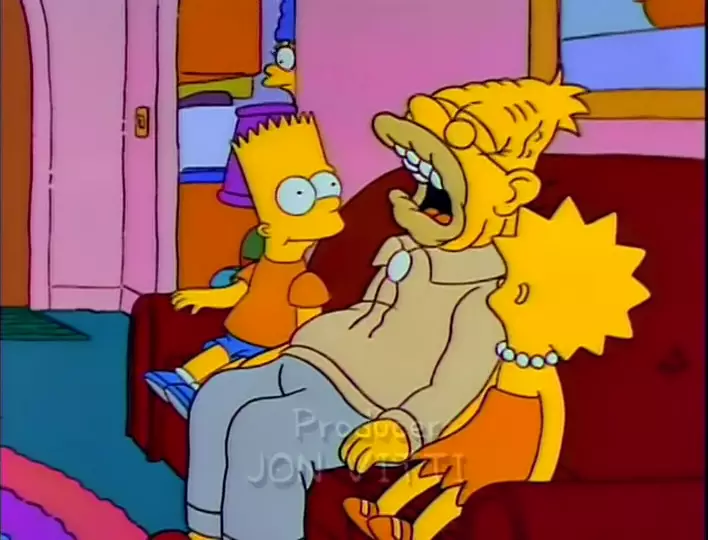
2:10. The brief but audible Grampa snore as Lisa asks her question, and the lengthening drool, indicates the show is aware of Grampa’s continued, irrelevant presence and wants you to be aware of it too. This keeps a soft tether to his passing out, and very subtly extends the joke.
2:17. Homer’s go-to punishment, his opposite of pizza, being poison is both very funny and actually relevant to his inability to effectively punish Bart.
2:25. “I’m not making two stops” is one of those little Homer moments that exist because he’s stupid and saying it seriously but would also work as a funny thing for someone to say in the moment. Colonel Homer is full of these.
2:27. I love this shot of the car and the use of a fish-eye curve. Technology has kind of killed it. Widescreen makes pulling this off difficult as the vanishing points grow too far from the car for the vanishing point curve to work and computer assistance has made animating loads of bespoke backgrounds an easy task. Like a lot of creative features that were originally a result of low-tech, such as black and white, they eventually become expressive creative choices. Here, the tiny arc of their small, repeating world is matched by their drive.
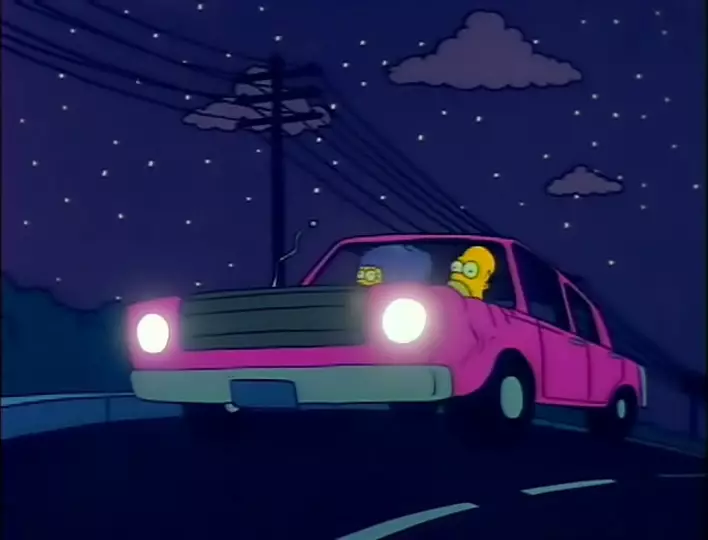
2:33 “That’s the way we do it every year” is a bit off considering Lisa is in the second grade.
2:38. There’s a subtle level of what the kids call shade to some of Marge’s moments that one can only really appreciate with age. Marge didn’t “guess” the answer, 37 is Homer’s age and he’s probably done this before. She answers in the actual blink of an eye, without changing her expression, and very dryly. With a more nuanced understanding of Marge as a person, this is a savage burn.
2:42. Homer breaking into pathetic begging almost immediately is the kind of display that lets Marge balance an internal ledger of indignities.
2.48. The “USA” chant here is a great stab at Homer and the kind of people who can burst into a “USA” chant whether it’s appropriate or not.
2:51. As a non-practicing teacher, “Let’s Share the Blame” is funny but no, the child is your fault.
2:56. Love Willie’s grunt here.
3:02. Children’s desks, ones designed for 8-year-olds, do not fit any but the tiniest of adults. It would be insane to expect parents to sit in them at all, let alone fat dads.
This is a good scene for some extra data on the other students at Springfield Elementary, though. We have what looks like Janey’s mum but she’s sitting at a desk for Charles who I’d assume to be Chuck but his last name is Berger. And this demonstrates some of the trouble with getting solid data out of moments like this, particularly in the early series. The show never particularly cared.
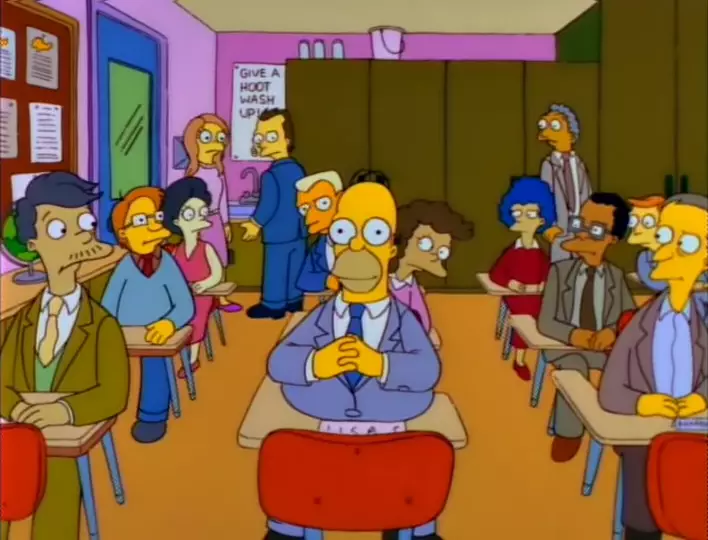
3:09. An inability to correctly read social information would indicate some diagnosable component to Homer’s stupidity.
The armpit fart gag with everyone staring at Homer is funny, but his little chuckle adds a bit. That he thinks he got away with it cements the meaning of the joke to be that he’s an idiot and not that he was using some level of irony.
3:15. I love olden days ideas of delinquent child belongings. A chain and a slingshot seem fair, and while corpse parts seem like an odd choice, I’d have totally grabbed a skull when I was a young’un.
3:18. The great thing about Marge’s little smile here is that it’s forced. The doll is innocent, at least so far, and she doesn’t know it’s actually a knife, but she can’t even bring herself to believe that it’s really good. She has to smile and hope at the same time. Naturally, that hope is dashed.
3:20. The thing about all these items is really how useless they are to any child who isn’t dwelling in a failed state, favela, or slum. Kids accrue these items as totems of potent masculinity they’ve learned to associate with threat, but there ain’t a lot of stabbings in the suburbs. I could see stabbing Nelson, but that’s never come up.
3:33 Marcia Wallace again injects Krabappel with character beyond her role which helps sell lines like “atrocities”. The sound of the crinkled paper as she grits her teeth through the replaced birth control pill line adds to it.
3:38. “Now’s our chance to be bad”. There are a lot of moments in comedy where you can see that whatever is being said or done is a clear setup for a contradiction gag, but this one hides it in the school narrative pretty well. About the only clue is that it’s been a little while since we’ve seen what the kids are up to, and the story is about Bart’s misbehaviour.
3:41. Gah! Face Monster! This figure looks kinda like Ralph and I figure he was intended as the Ralph Dad model until they decided to burden Wiggum with him.
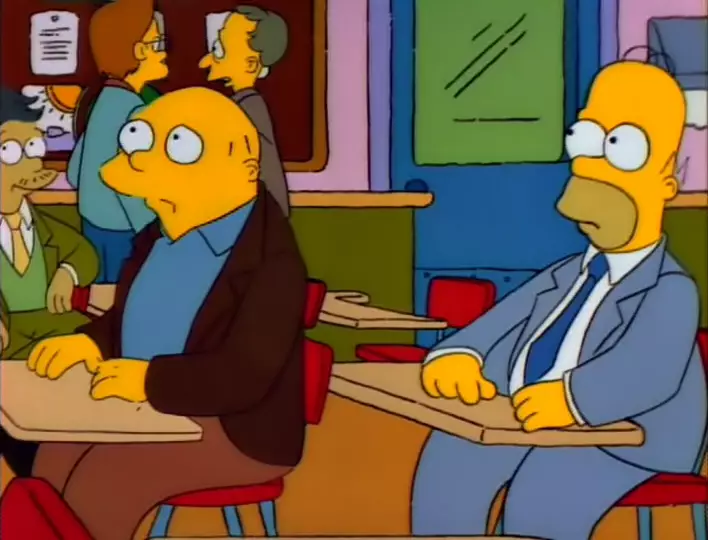
3:56. Another “nobody who wrote here studied education” moment. Reading the TV guide to a child is as good as reading anything, if not a little better given Lisa’s predilection for language. Homer is letting Lisa see what he’s looking at so she can follow along, and he modifies his voice to indicate the function of punctuation in marking Henry Winkler’s name as supplementary information. About the most you could add is tracing the sentence with his finger to assist in focus, otherwise this is good parenting and will have legitimately impacted Lisa if he did it regularly. If anything has no nutritional value, it’s those infant programs that have little to no language. A child’s brain is a learning sponge like nothing else in the known universe, throw everything you can at it.
4:03. This shot is funny because it reminds me of a few of those scenes where we see his imagination or recollection of an event that places him in the centre of attention like this. It connects well to the running theme of him really wanting to feel respected.
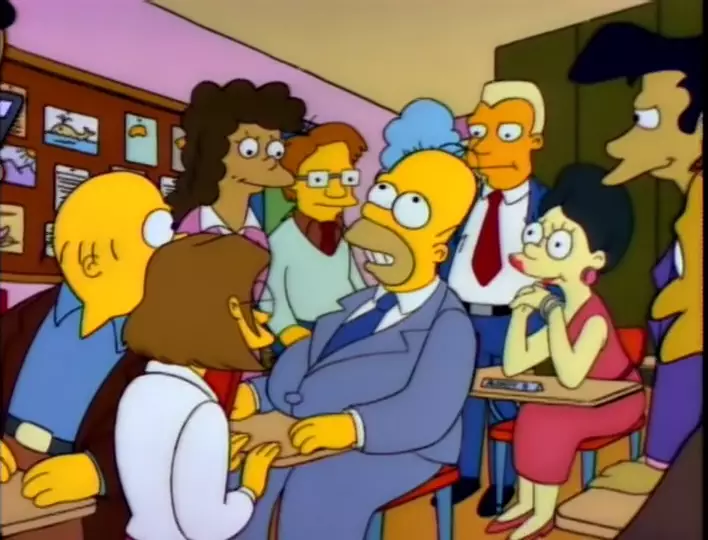
4:08. The pull out ending outside the school for a full second is a little odd and bears a similarity to a different technique they use I’ll discuss in a few episodes, but it works well as a bridge back to Marge.
4:10. More great Wallace work on the enunciated “u-sually” here, which is being emphasised to show how Krabappel is taking everything she has out on Marge.
4:15. It’s not exactly Molested Face on Arthur here, though it has become that, it’s the general face of a kid who knows something has taken place that’s wrong, but he lacks the maturity to really grasp it.
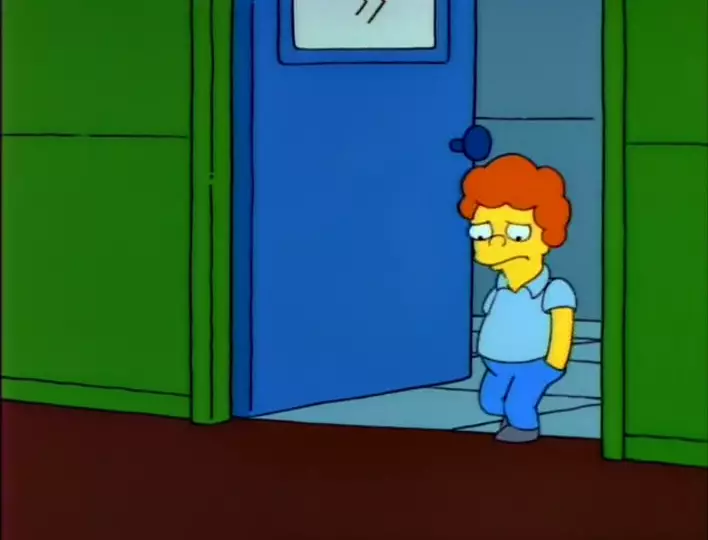
4:18. It is not a good sign when the “where did he touch you” doll is modelled after you.
4:21. There are only so many places fireworks can be stuck, so the question becomes what end?
4:23. The reused hentai sounding effects for Grampa’s false teeth slipping in his mouth really add to the gross factor.
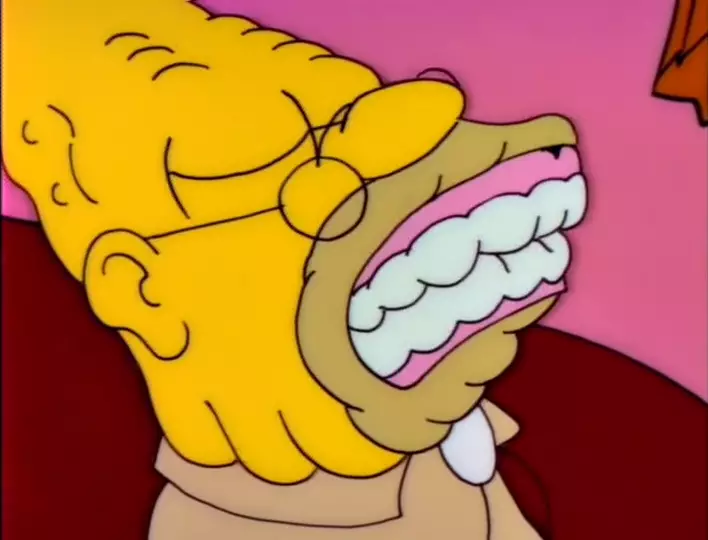
4:26. The widening shot to reveal Bart, his little rhyme, and his sisters watching is a goodun. I love the look on Lisa’s face here. It’s the same one I get when I’m watching something take place that I won’t be held responsible for.
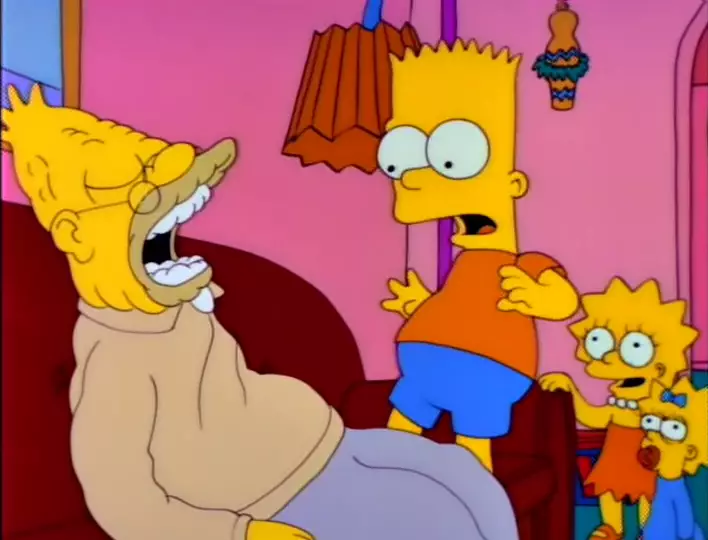
4:31. Putting just removed grandparent dentures into my own mouth is a fucking gross idea, so I agree with Lisa but you gotta admire Bart’s commitment to mischief.
4:32. Bart’s warped face filled with big, giant teeth is a great visual and the show makes good use of it.

4:38. There’s a kind of injustice setup in how Homer and Marge experience the parent/teacher meeting that doesn’t get paid off, but there are enough major plot shifts to kind of blur it into the general dysfunction of the marriage.
4:48. Well, thanks to this stupid moment, I now have far too much knowledge on “Where’s the Beef?” It started as a Wendy’s ad, where the original line was to be the far less catchy “Where is all the beef”, but got shortened when the actress, Clara Peller’s emphysema made it too hard. It became a meme, got used by Walter Mondale in the ’84 Democratic primary, and, because may god curse our species, was turned into a fucking song by a DJ named Coyote. Listen and suffer.
4:54. Barely a joke, those desks are TINY.
4:57. There are moments where you see the child in Lisa, and they are usually paired with Bart being a maniac. It’s something I wish the series had spotted or meaningfully addressed. There’s no reason to be putting on Sabre Dance here aside from the knowledge that it’s the perfect accompaniment to mayhem, which is the exact form of encouragement that would have teachers brand me a “ringleader”. It’s also a fun way of turning what would have otherwise been non-diegetic music into a good joke.
4:59. The reveal of Bart chomping down on the ceiling fan is fantastic, it’s a beautifully deranged escalation. That said, I’d have let Sabre Dance start a second or two earlier to get the drums involved. They create perfect setup energy. This moment really demonstrates the utility of music and the way some of these compositions become irrevocably bound to feelings. I’m deeply appreciating the decision to use Lisa putting it on as the source as it’s a marvellous multiplier. It’s a good thing to think about as you watch other things as it can go unnoticed.
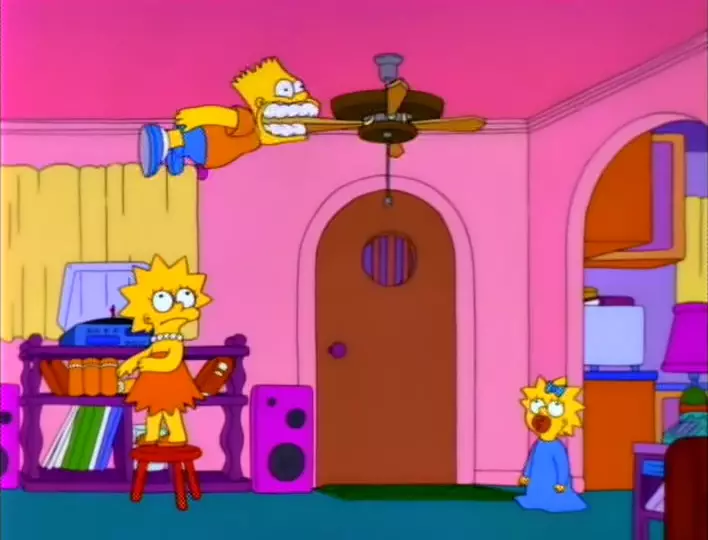
Some shots here remind me of 2D fighters, where there’ll be bespoke sprites for some grappler’s spinning whatever. Zangief didn’t get any, but, of all things, Muscle Power from World Heroes Perfect had some for his Giant Swing super.
5:03. The fanblade shot of Bart is a great one. Animation can actually struggle with these kinds of shots, the background is a repeat pan, but a large part of the value of this stems from the show’s realism.
5:08. Marge writing lines is funny but also serves as a good in point as the amount of time this has taken diffuses the tension build from the molestation doll scene.
5:12. Having comedy characters be aware of the absurdity of situations they’re in is risky as I can make decisions or behaviours necessary for the joke break the world’s established reality. Marge writing lines is, for this period, close to that, but evidence of Bart’s behaviour combined with her doormat nature have left her desperate to atone and unable to resist. She can’t see how writing lines will help Bart, but realistically can’t muster the courage to do anything. She can only feebly grunt to herself.
5:14. Similarly, Homer’s stupidity and desperate need to feel better than anyone makes funny but wildly inappropriate behaviour like “BUST-ED” work.
5:26. Homer goes a little too long on the badmouthing Lisa bit, but the payoff of “Oh… That guy” is a goodun.
5:33. The idea that Homer and Marge just aren’t very good at punishing the more cunning Bart is one of those background ideas that can keep the issue of his constant misbehaviour in a stable orbit, but it has to come up again, successfully or otherwise, to function like that. The Simpsons has a few things like this, like the fan theory that Homer stays employed because his incompetence as safety inspector benefits Burns, but they remain fan-canon.
5:47. The thing about discipline is it can only function if you take the tribal sense of self into consideration. Krabappel’s discipline will never work on Bart because it’s become integrated into his sense of self. Transgression is Bart’s new marker, so punishments are badges of honour. This is the entire basis of modern troll egos.
5:51. Chief Justice of the Supreme Court is some wild oversell here, Krabappel.
6:01. Krabappel in the background as Homer fantasises about what Warren Burger tastes like is another great example of the not-quite-neutral neutral face being really funny in contexts like this.
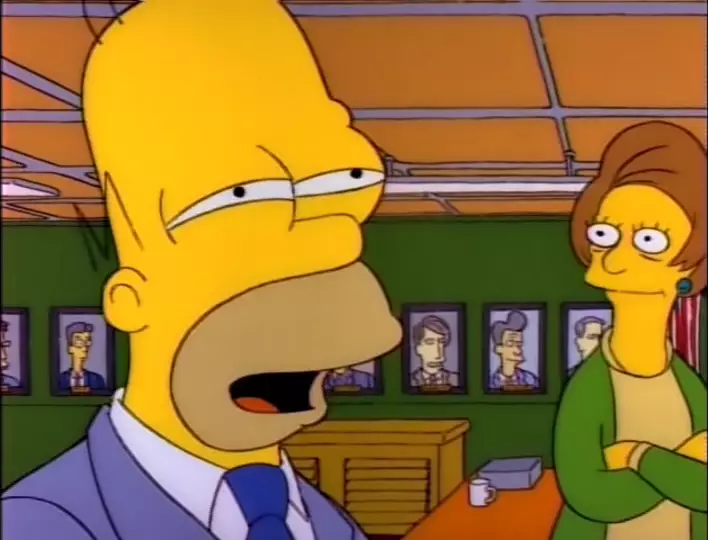
6:11. One little detail I love about this fantasy sequence is that it’s Marge’s and this means she came up with her own son’s stripper name.
6:24. A LOT of good gifs and shots in this scene. The sound when the bottle hits his head is very wrong, though. The sound is more of a metallic TUNK sound, than the cartoon BOP. Also of note, Bart’s face changes expression before the bottle has even hit his head.
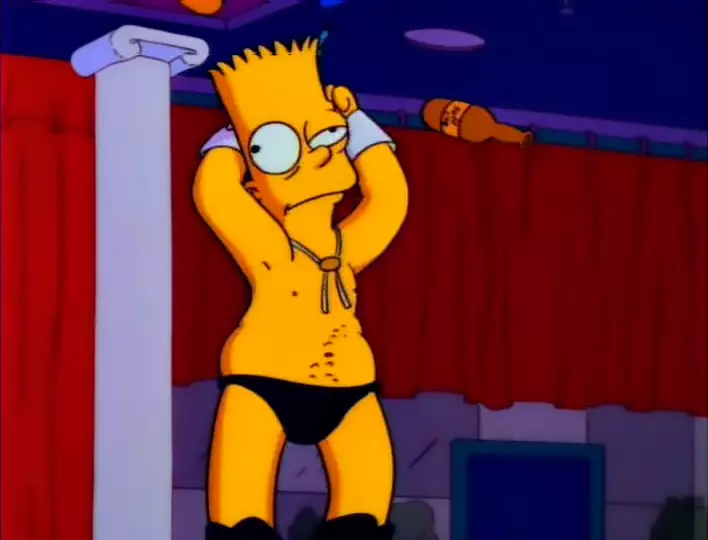
6:25. Bart is demonstrating why cocaine is the stripper drug, not booze and also the disposability of sex workers as a rampaging audience of horny women suffer no consequences for assaulting him. I’m curious if Nancy Cartwright did Bart’s lower adult voice by herself or if it got slowed down at all. Either way, the long groan here is a goodun.
6:30. Krabappel, staring at parents while they daydream, starting to connect dots.
6:32. The commentary mentions that biting LPs was a thing teens did but all I can find are stock photos.
6:37. The teeth on the ground is one of those moments where you get to see the limitations of the art style. Nobody draws a big cartoon grin like they’re going to one day draw these with some degree of anatomical accuracy. A similar process occurs with the children’s hair.
6:42. Now THAT’S a junk drawer. I haven’t had one since I sobered up and gained both the mental capacity to meaningfully repair things and the money to buy the necessary tools.
6:46. I’d mock Bart here but having to reassemble dentures in about 15 seconds is a high-pressure game nobody wins. I have the feeling this joke will go over the heads of some youth, as it looks like the boomers are hanging on to their teeth better than their parents did. My grandparents were old when they were in their 50s, false teeth and all, my parents are in their 60s and still have all their original parts. Hopefully, by the time I’m that old, I’ll have even MORE teeth.
6:50. Some great foley on this moment. The sound of old person mouth, the unmistakable tacky crackle of sticky tape, and the occasional toothy conk sound really add to this moment.
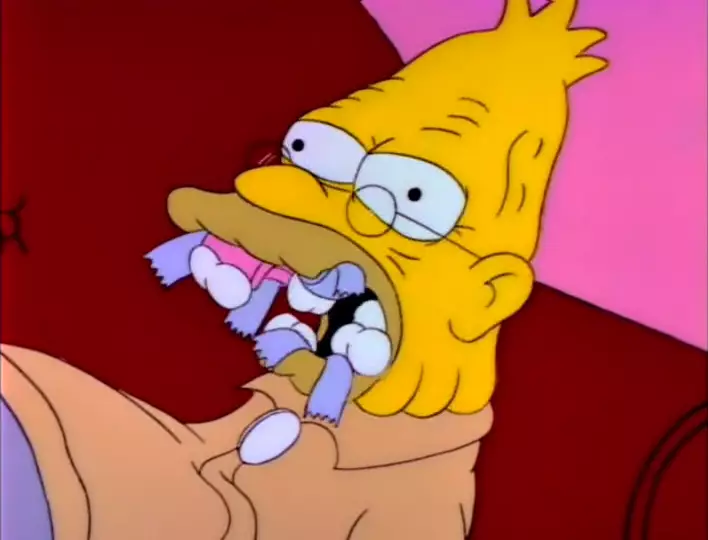
6:54. Grampa struggling with his taped dentures in this moment is another doozy. I feel like this episode could also have been about making Bart work with Grampa as punishment.
7:14. The elderly are fascinating things in comedy because they’re generally easy to perceive as frail and harmless, yet they make perfect punishment targets. This isn’t a Milhouse situation, where your pity and compassion are driven to such extremes as to circle back around, it’s more to do with the comedy coming from an inversion of the “respected elder” phenomena in human social groups. It’s still there as an instinct, even now that we know the elderly are mostly useless, and is the source of a a kind of subconscious power we delight in seeing inverted.
7:14. “The crooked home we saw on 60 Minutes” is a good threat because it’s both dementedly extreme but feasible.
7:26. This great run of lines from Homer is a good follow-up to my earlier point. This may seem like a series of jokes about how Homer’s so stupid that his list of “wacky Grampa lies” are all probably real things, but this is just the vector for a joke about people ignoring the elderly.
7:37. As I was saying earlier, there is a difference between punishing Bart and choking the life out of him and Homer demonstrates it perfectly here. Something bad happens to Bart only when it drives Homer to an immediate emotional reaction, and that’s not punishment so much as revenge. If he has to process a series of events, he’s immediately lost and vulnerable to Bart’s manipulation. The comic value of the abuse means we see a lot of it and could be fooled into thinking Homer is a stern parent, but this moment here where he wants to get Bart a present is the real nature of the relationship.
7:49. “Since you broke Grampa’s teeth, he gets to break yours” is a great line because it’s natural to the scene and character while still being funny to the audience. This principle and a lack of universal audience has gotten me in trouble more times than I’d like to admit. Grampa being totally into breaking Bart’s teeth is a great addition. Is he putting it on for revenge or is his old-school one that broke teeth? Hard to tell. I’d make new dentures from the child’s baby teeth and then bite them.
7:53. My vote is that Grampa was going to do it, but his pawing suggests it was going to be an artless method.
8:03. A bit like Malcolm in Malcolm in the Middle, Bart’s situational cleverness is often overcome by his age’s native impulsiveness. If your success needs you to look beat, rubbing a presumed victory in your mother’s face is not the best approach.
8:10. Of minor note here is how Bart’s confidence is the setup for this joke, where the opposite has occurred, which would usually be a hard cut gag, but there is the little Grampa bit in between. It doesn’t wreck the joke, but it’s an addition that doesn’t take the structure of its surroundings into account and so doesn’t add anything either.
8:14. The detritus of Bart’s room is of a bygone era.
8:15. It really does fit, given what we see in later episodes about the past, that Homer is desperate for his son to like him.
8:32. Santa’s Little Helper makes a decent pizza.
9:00. The thing about Bart’s problem being merely inadequate consequences for misbehaviour around the home, ignoring even the other indications of some measurable disorder, is it really makes Bart too much of a villain, a problem this scene drives to the forefront. If I mug someone and say, “sorry, I had a rough childhood” my self-awareness of that indicates a level of self-awareness that lets me understand my behaviour in greater social contexts. As a character, Bart is dancing on a line of maturity and intelligence that would force this problem, but for the series, a level of youthful self-ignorance would work to extend the life of this. Reece in Malcolm in the Middle is depicted as overtly malicious, but also far too stupid to understand it and far too stupid to avoid various consequences and punishments that even his karmic score. Depicting Bart as clever and manipulative in one scene and then knowingly villainous in the next is a damaging level of sociopathy. Simply having him smile while eating the pizza would have allowed the problem of Homer caving to be known, while keeping Bart’s understanding vague or subconscious. Here, he just looks like a piece of shit who deserves every pain that comes his way.
9:12. Grampa playing tooth-fairy is funny enough, particularly Jasper’s reaction, but it needed a setup. It’s too distant in space and narrative for the cut to make logical sense from the last scene. A setup of Marge talking about the teeth would have supported the moment.
9:22. I love the detail of Scratchy’s tongue also changing colour after the clippers went over it.
9:25. The bunny ears coming between the flamethrower through the head and the scalping gunshot is amusingly placed.
9:30. The violence of Itchy and Scratchy is of an interesting blend because there are definitely elements of the old cartoony style, but it’s peppered with the far more graphic modern form. The old-style cartoons did have a lot of violence, but it was always the vaudevillian comedy type whose capacity to offend modern sensibilities would stem more from concept, like suicide, than content. Itchy and Scratchy is a parody but plays more like a parody of how parents saw those cartoons than how those cartoons actually were. Eventually, Happy Tree Friends would be what Itchy and Scratchy pretended to be and was reasonably entertaining.
9:33. Finding out a movie has been made of something you like through a trailer on TV is a plot that won’t make sense to modern children.
9:42. My cousin learned the hard way that many plastic figures have little metal bits in them that the microwave doesn’t play well with. I appreciate Bart’s commitment to making this act of destruction something creative and fun, though.
9:56. I figure an Itchy and Scratchy movie could work a little bit like that Eric Andre movie, Bad Trip where a simple narrative framing device creates moments for the micro-episodic stunts to play out. Actually, more like that Johnny Knoxville movie, Action Point which is based on an actual place, Action Park, which had a good documentary made about it called Class Action Park that I recommend.
10:11. The love hearts being treated as physical items drifting to the ground is a clever comic inversion of their use as representative icons. The cartoonier cartoons play around like that a bit.
10:19. The joke “53% new footage” is another one that won’t quite carry for the modern kids with their well animated, well written cartoons with story arcs and conclusions. Back in the day, Warner Bros would flop out 4 Bugs cartoons slammed together with a some re-voiced filler material and call it a movie.
10:29. I love the goats. The extra effort that The Simpsons goes to in order to create a sense of reality makes things like goats a wild surprise, but the choice of goats is a good one because they’re the kind of thing that can happen. You can get a goat delivered to your door in Queensland for less than 100 dollars and I almost did that once to get out of yard work. If I walked into the kitchen and saw a goat eating from my bin, I’d be surprised but there are still too many rational reasons for that to happen, even though it has never, ever happened. This is the small gap this gag works in and it’s one that it uses by having Homer address the goats like they’re not a wild surprise. He just tells them to get out of there and one hisses at him. It’s all very cartoon strange but completely possible at the same time.
10:31. Great high to low angle work here. Starting with the shot from behind Homer’s head to Bart on the ground then shifting to the reverse establishes a very clear sense of physical hierarchy that supports the expected punisher/punished relationship. The close cut to Bart once he starts talking is from essentially the same angle, but the proximity eliminates most of the obvious markers a 2D cartoon needs to create depth which is mirrored in the next close-up on Homer. This shift from obvious hierarchy to blurred hierarchy emphasises the narrative components at work, before a cut to a mid-shot of the pair that shows Bart stand up and Homer sit down, completing the power inversion.
10:52. Being Australian, watching The Simpsons was an interesting affair as most American television translates near perfectly across the Greater Western Smear, making the bits that don’t into fascinating curios. Bumblebee Man is one such curio. My school had a few Central American refugees, but Australia’s lack of a bordering Latin American nation meant most of my understanding of that cultural block was via things like Sesame Street and other integrative American media. I’d seen maybe some kind of reference to odd Mexican television as a kid to get the basic structure of the Bumblebee Man gag but had no idea who he was actually based on until I researched it for this.
It’s a character called “El Chapulín Colorado” (The Red Grasshopper) played by Mexican comedy legend Roberto Gómez Bolaños. Going by the name “Chespirito” (which would later become Bumblebee Man’s last name) his Red Grasshopper had an eponymous comedy show, largely a parody of superheros, that was huge in Latin America. His cultural legacy is very impressive, there’s a Marvel hero based on him, and he’s even been added to Fortnite. It’s an odd program as there’s almost no continuity between episodes, but you can see how it turned into Bumblebee Man via Matt Groening watching bits of it while near the border.
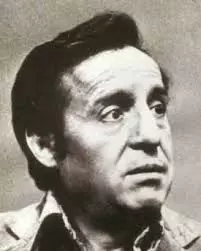
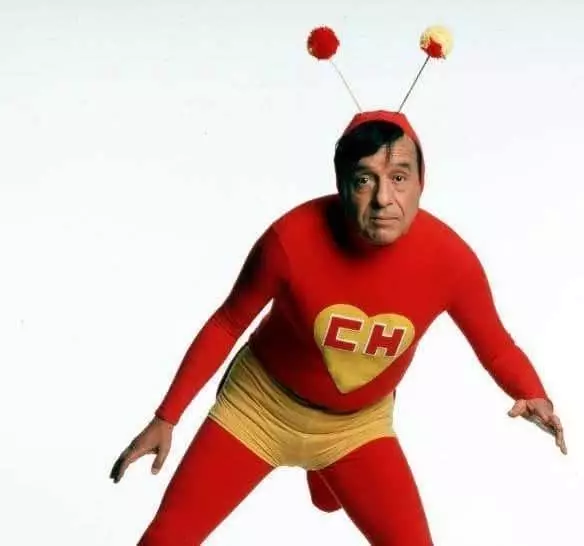
10:58. Homer giving up here is a conscious act to avoid his own responsibilities. Laughing and calling Bart a scamp means he knows that Bart hasn’t manipulated him exactly, just turned him into an accessory. It doesn’t balance with the goats, but those exist in the comedy dimension and forgetting to take the trash out isn’t a significant act of misbehaviour, so it fits well enough.
11:00. This bit with the billboard gushing blood everywhere tends to get cut in syndication. I’m not 100% sure it ever made it to the 6pm slot in Australia at all.
11:09. Bart smashing mustard packets to “Jingle Bells” has always been a favourite. Homer’s declaration of “No tricks, boy” when Bart tries to talk his way out of it doesn’t quite fit with what happened last time, and while the moment makes Homer the problem this time, he was the last time as well. Not caring enough to stick to the punishment and forgetting it because of ice-cream are different faults but they are both Homer’s.
11:32. I’ve a soft spot for the accidental comic absurdity of incredibly offensive mascots because there just aren’t quite enough to make it feel like it was a thing of its time. Not that people would have been upset, but that there was still a kind of genteel manner that made these things cross a separate, irrelevant line. So rather than this simple strata of “here are the wildly offensive mascots” they still have to be discovered. “Big Chief Crazy Cone” is barely offensive, all things considered, but it’s odd to choose native Americans as ice-cream vectors in the first place.
11:36. Another great smile from the ice-cream man as he watches an adult shove children to the ground.
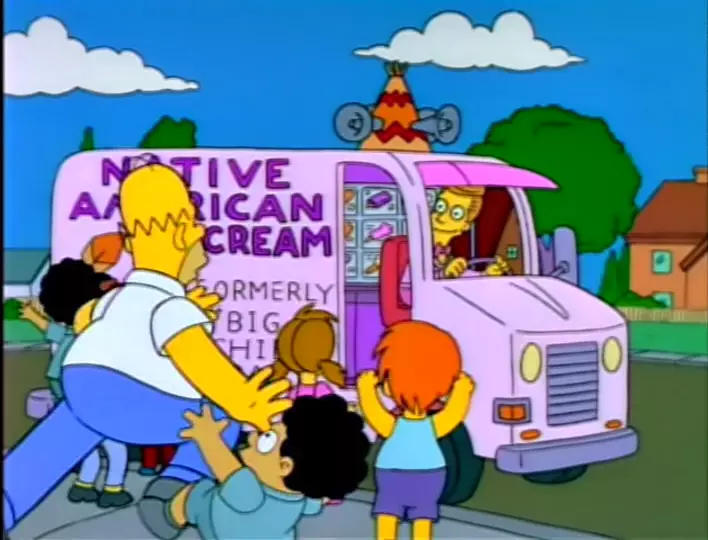
11:53. The US approach to jury duty is odd, as here you can just say you can’t because of work or something and they let you go without even checking.
11:54. Another nice use of a close-up on whatever destruction Bart is engaged in.
The thing about this scene is the story could easily have Homer act like this if he’d given up punishing Bart after being beaten too many times. The escalation of Homer’s responses from the garbage to the mustard packets indicates an escalation of awareness that needs to peak. Instead, it just resets, and Homer doesn’t care for some reason. It’s bothered me forever.
11:59. I gotta find out where Lisa’s exclamation of, “WE GOT BEETS!” came from. It’s one of those subtle ones that gets lost amidst the starring lines, but it stuck with me.
12:00. Homer’s muzzle here turns yellow.
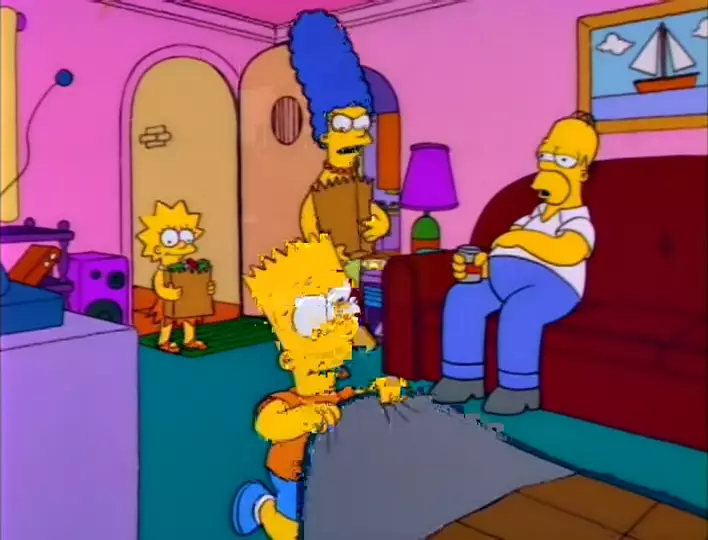
12:18. The thing about misplacing the reactions in the sequence is it makes this moment where Homer aggressively reacts to Marge’s surprise more abusive than funny. Homer’s characterisation gets back on track, but it’s such a glaring error.
12:49. Ah, having to watch Entertainment Tonight to see trailers or clips of movies. You’d have to watch a whole episode of John Tesh’s forehead because they’d constantly tease the thing you were actually interested in, and half the time it wasn’t even the full trailer. They also gave away the whole twist of Terminator 2. Fucking jerks.
12:57. Computers have put all these poor Korean slaves out of work. The commentary mentions that Greg Vanzo was a bit annoyed by the depiction of the animator’s working conditions.
13:25. The funny thing about old cartoons was the insane effort that went into making them. There’s a thing floating around about a Popeye short that involved an absolutely mindboggling amount of effort that I recommend finding.
13:30. It’s easy to see early films or shorts and see them as simple in a narrative sense, and a lot certainly are, but there’s error in interpreting that to mean things are growing endlessly more complicated. Entirely new mediums go through the same growth patterns, with the exception of VR which is still trying to nail down some tech limitations. For an idea around 40 years old, it’s still in its “That Happy Cat” phase of being fun simply by adequately performing its task and has yet to really expand on much of it.
14:10. Love the sound of Scratchy groaning as he crawls on his bleeding knees.
14:25. Showing Maggie leaving here is a nice bit of setup as she clearly looks at him and figures she isn’t being watched. This shifts the blame to Bart, and specifically his irresponsibility, as cartoon Maggie is more than capable of fairly tricking adults.
14:33. I like the generationally appropriate change in animation styles for the WW2 propaganda piece. The nails going through Hitler’s groin is another nice touch. Of note in this scene is the way the red blood makes a rare appearance. I’m guessing this was accepted as the victim was Hitler, which would have forced potential censors into the position of arguing “tone down the violence on Hitler”. American WW2 propaganda always rings a little hollow due to the staggering racism of its own society.
14:45. There’s something just a teensy bit off about FDR’s reaction to seeing a cat corpse presenting.
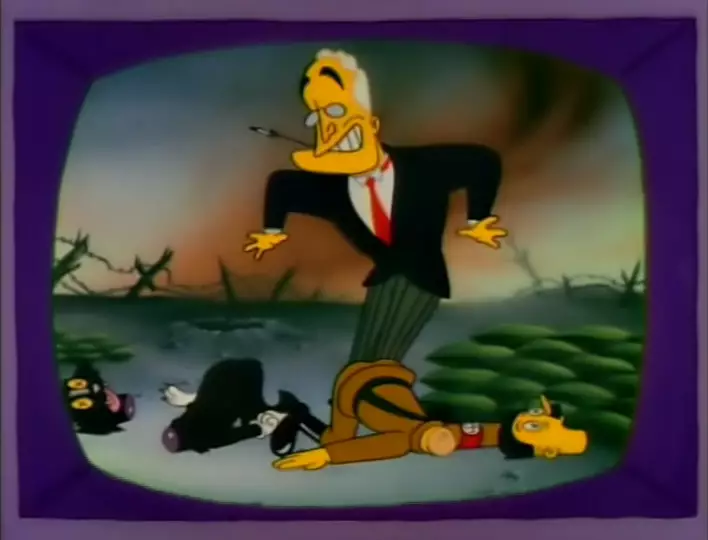
14:53. I love the “Eye on Springfield” bits because they are such a perfect parody. The desperation in how they’d tie whatever bullshit they were reporting on to whatever bullshit they were promoting would lead to loads of “real life Itchy and Scratchy” moments.
15:05. One thing I’d bump into occasionally was people not getting how I can like or praise a part of a thing, while still not liking the whole. This is called “critique” and requires both knowing stuff and doing actual work. Pursuant to this, I love the Maggie sequence in the car even though it winds up fucking the plot about. Anyone who can’t separate things like this doesn’t know what they’re doing and shouldn’t be listened to.
15:55. “C’mon Homer, this isn’t funny”. Love the front pocket on Bart’s shirt existing for only this moment.
This sequence illustrates a good point about how there is a difference between what your characters think, what your viewers think, and how managing the two requires care. There are plenty of softening elements in Maggie’s car ride. She’s always depicted as enjoying it, the music has a fun adventure tone, there is never a sense of real danger, and the dramatic crash shows Maggie curling up to sleep on the airbag, entirely unphased. The viewer sees all this, knows The Simpsons is a comedy, and therefore the sequence is light. Aside from skipping any noticeable consequences, the show does nothing to make that the interpretation the characters should come to. Whether or not viewer/character opinions of events align is not an innate need, but it is one when plot elements demand it, such as when the family turn on Homer for being too strict.
16:05. Awkward front shot of Bart here where his cylindrical head shows its problems. As odd as the mouth comes across as, a neutral expression actually looks worse.
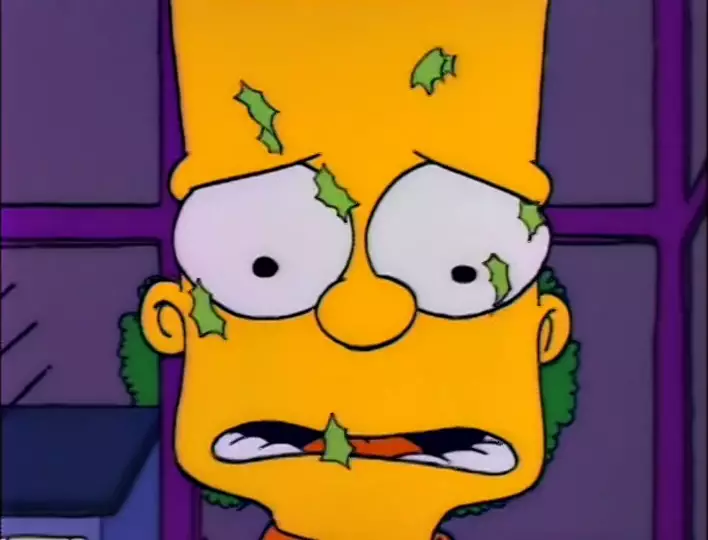
16:09. Snake running by the window here is great. I love using micro joke spaces as callbacks and this one also creates a sense of spatial continuity in Springfield, particularly because Homer notices him. Things like this make jokes real in the moment and connects them to the surrounding narrative universe, instead of being interchangeable cartridges slotted in and out for guffawing invisible gods.

The Beta line here is another lost reference. There are conspiratorial ideas around the failure of Beta because it had better video quality, but a head start in bringing home 90-minute movies was one of a number of impossible hurdles for Beta, though it maintained use in industrial settings. Beta was dead in Australia by the time this episode even came out, but Sony kept producing the consumer tapes till about 2015, which is fucking wild.
16:23. “Don’t point that thing at me” is a good dad line.
16:30. Lisa’s plea here is solid, but only works if the primary motivator for the severity of the punishment is Homer’s internal need to stick to it. As said above, there isn’t a reason for Lisa the character to feel this way, but it slides because it’s how the audience feels.
16:37. The moon landing as an example is an unforced error from Lisa, who should really know better by this stage.
16:44. Trying to work out what the hell is painted behind Grampa here. It’s probably based on something real but looks like a giant grandma having her head explode into psychedelic paisley. I doubt the Mother Simpson lore was established at this point, but it can fit into it.
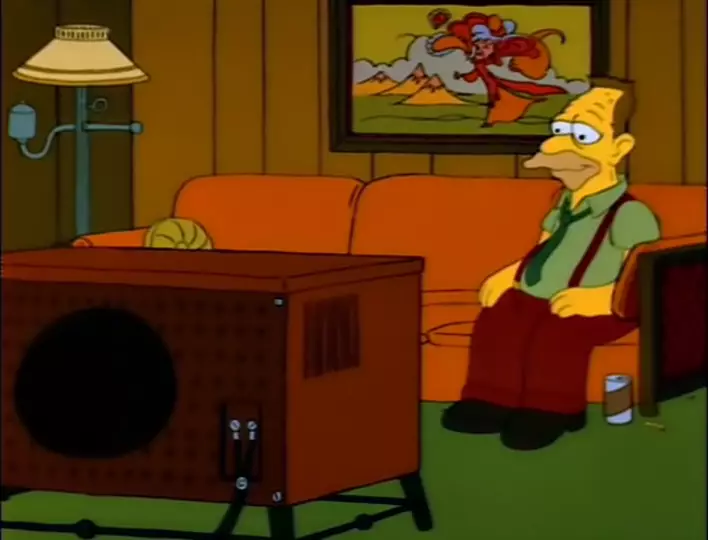
16:48. The expected gag from the setup and knowledge of Homer’s character is that he didn’t care about the moon landing, but this scene does a great job of cranking that beyond even the expected. He’s sitting right there, but he has his eyes closed as he listens to a bubblegum pop song by a band that wasn’t even a band. The fade back to him singing it in front of his family is similarly brilliant.
17:04. Milhouse is first in line, good for him. Ned would make sense if he were alone, he’d be watching it for some lunatic religious recommendation reason, but Rodd being there is out of character. Shutton, Hutz, and Mr Largo disappear into the crowd.
17:11. First sighting of the Springfield bascule (comes from the French for see-saw) bridge that Homer would get his head stuck in later. “I regret nothing” feels like a jab at people who line up for movies like this, which was a better burn 30 years ago.
17:14. There are a remarkable amount of unique character designs in the line, including hatless Mario here.
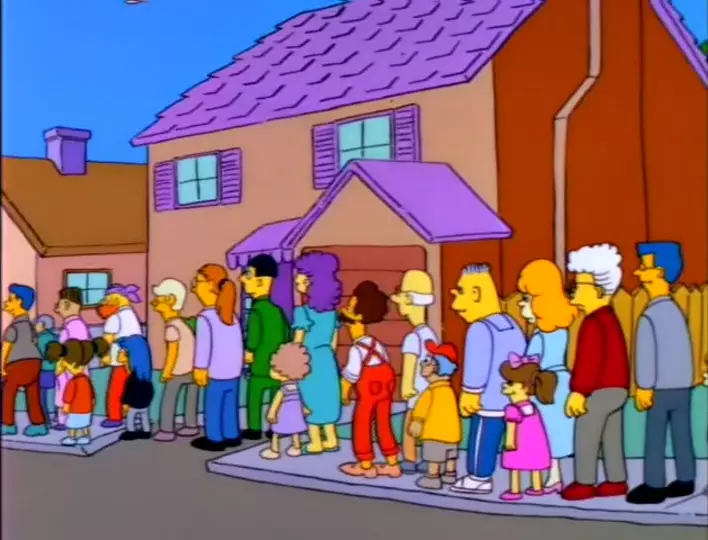
17:16. Wendell walking up to the line as it ends at the Simpson house is a nice highlighter.
17:23. “No bloody likely” is an odd turn of phrase for Bart, but it popped up in an episode of Seinfeld a year earlier which possibly explains both its presence among the writers and even the in-universe Bart.
17:40. Some great tone of voice work in Homer’s story about banging his head on the coffee table.
17:51. This conversation is an interesting one because it manages to never be about actually changing Bart’s behaviour. In terms of actual parenting, this is demented, as the whole point is to create associations in the child’s brain that will make future misbehaviour seem like too great a risk. Here it’s presented as a puzzle that will pay off at some future point.
17:55. Homer being upset that Bart said, “TV sucks” is a good example of cartoon stupidity but blended among more natural behaviours makes it an effective seasoning. Cutting to Bart miserably watching some show on mailbox creation is a nice touch. It’s connected in a way that makes it funny, but not in a direct setup/punchline way as Homer’s line took that spot. Combined with the fact that Bart has natural narrative motivations to be suffering through bleak Sunday programming and the result has an emergent comedy quality to it.
18:13. Yeah, imagination is great, but external stimuli carry the thrill of the unknown. As someone who was a kid when things like Lord of the Rings were deemed unfilmable on giant battle scenes alone, I’ll take the fucking movies.
18:17. The look on Bart’s face here as he realises he can’t imagine anything carries a more extreme distress than the moment is aiming for.
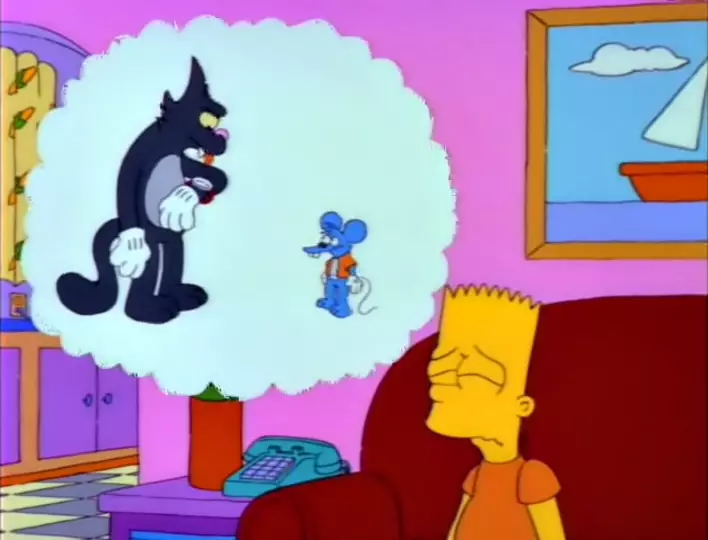
18:30. There’s a lot of meta-commentary about The Simpsons and the idea of doing a movie that was being discussed at the time, so the ep uses this as an opportunity to confirm the Dustin Hoffman and Michael Jackson credits.
18:39. I’ve only read excerpts of Mailer for a course, but going by those his novelisation of Itchy and Scratchy would be tremendously entertaining for people like me and probably somewhat scarring for a child. Novelisations are odd things, probably artefacts of a bygone media era that linger only because they’re so cheap to produce. I have the Spider-Man 3 novelisation on my bookshelf because its existence astonishes me. What kind of person who would rather read a book than see a movie read the novelisation of Spider-Man 3?
18:45. Huh, magic 8 ball in the trash.

18:53. I’m amazed Nelson has the money to see Itchy and Scratchy 17 times, but he’s probably sneaking in. I don’t know if there’s a single movie I’ve watched that many times. TV is easy because it’s short.
18:56. The innate tribalism of humans is so fascinatingly raw in children that moments like this one aren’t a joke. Nelson bullies Milhouse, a lot, but that doesn’t matter because Bart hasn’t seen The Movie. The shot where Nelson and Milhouse look at each other before turning on Bart is a goodun. The moment some ancient piece of brain detects a signal our conscious minds can’t.
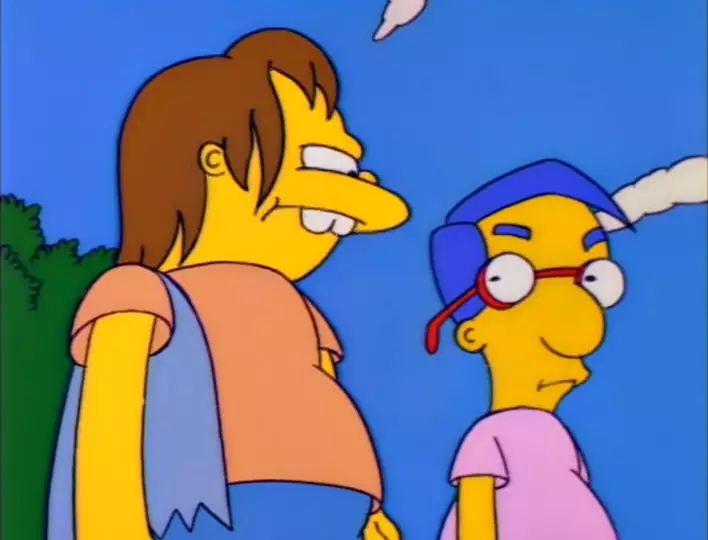
19:19. There are a series of moments where Homer responds to some reference he absolutely doesn’t know with a confident guess that fits perfectly.
19:25. Marge’s line “gotten through to him” is really the failure point here. Nothing has gotten through to Bart, nor can it, but she could have made the argument that the severity of the punishment was doing more harm than good. Driving Bart away from his parents is a good way to have him end up a sleazy male stripper and that angle would go a ways to fixing this point.
19:27. Homer’s absolute commitment to whatever he thinks at that second makes his inversion of his and Marge’s positions genuine and far more irritating.
19:40. I looked it up, and there is no Mr Tight Buns competition.
19:45. Homer’s line here reminds me of that bit in Austin Powers where he says, “Allow myself to introduce… myself” and cringes as he is consciously aware of the mistake he made. Homer isn’t so aware, and these represent two different structures of the same joke. This Simpson form is one that shows up a lot in Futurama and is a kind of one-hit word gag you can fill moments with. The Austin Powers sequence is a performance joke, where most of the comedy comes from an aware character selling the social embarrassment, leaving little room for extra material.
19:52. The scene with Bart trying to sneak into the movie is an interesting one as it represents an issue within fiction: what behaviours will your audience expect? Technically, this moment doesn’t need to exist as it doesn’t interact with anything else in the plot, but within the context of audience understandings of Bart the character, most will be thinking some variation of “why doesn’t he just sneak in?” The logic machine of plots manage tensions via expectations in the audience, and these expectations are influenced by their understandings of characters, social roles, and the ways these interact. Managing these requires care and often research but mean the difference between a plot that feels well executed and something like Prometheus.
19:54. Continuing on from the above point, the idea that a cinema usher would go along with what some random parent had asked them to do draws good comparisons. To some, this will be a disrespected minimum wage job whose customer base deserves no extra effort whatsoever, making this moment seem unreal. Put this in Japan, and Western ideas about that country’s sense of duty permeating into even minor roles turns it into something more believable. Here, it is just a little tag that uses the comedy tone to skirt any need to be taken too seriously. A bit like the plaque in the lunar lander in Futurama that called my dad out so damn hard.
20:09. The new billboard paper going up over that leaf bothers me greatly. It triggers the screen protector PTSD years of living in Brisbane share houses made mostly of dust has given me.
20:13. I’d hate to think how much it costs to keep this squirting billboard filled with pig’s blood. I’ve had learner hairdressers and barbers do my hair and it’s never been a disaster. Graduating to actual heads is only something you get to do after a while of dummies here, and your progress is closely monitored. I could imagine it being different in the States, but this feels like one of those old-timey gags that hasn’t been true since the 30s.
20:20. “Eight months and nine academy awards” This is meant to be a gag at the idea of the world treating this movie as though it were important. A fact that’s useful for the punishment element of it but it doesn’t work when the Academy has never respected animation or comedy. It’s a tiny, tiny, meaningless thing but is a good example of how accuracy is sometimes necessary for purposeful jokes.
20:30. This episode aired in late 1992, a year or so after Mickey Rourke had bombed out of acting and started his boxing career. The man had a string of well-regarded performances that garnered award nominations and sex symbol status, so this period of his life was seen as a nadir. He had the sexy absolutely thrashed out of him and got his late career resurgence playing lumbering, damaged monsters with heart.

20:39. This moment has all the beats of a meaningful lesson, but it still isn’t one. Bart’s identity is predicated on rebellion. This rebellion is constructed as being good, and that places it in opposition to authority structures that become unfair or invalid by default. Sticking to a punishment sounds good to people on the inside of this social structure, but to someone like Bart it’s just seen as more of something unfair, which is why a lot of approaches to fixing this are fundamentally flawed. Here the lesson is also incomplete, because it is entirely about Homer learning a lesson. Bart’s is open ended, which is absolutely not what you want to do for a child like Bart. If all this sounds too complicated for a sitcom, it is, which is why you should avoid doing it.
20:47. Another thing lost on modern audiences is the idea of “missing a movie” which piracy, streaming services, and omnipresent screens has rendered extinct. That feels like it may clash with this moment of Homer and Bart in 2032, but it’s easy to believe neither has thought about the film in some time rather than Bart being unable to access it in the intervening 40 years.
20:58. Little details, like Bart wearing his robes in a casual setting and the idea of there being a special discount for Supreme Court justices makes this moment feel like something in Homer’s imagination. The teen still working in the booth leans into that as well.
21:09. Soylent Green is actually based on a story by Harry Harrison called Make Room! Make Room! set in a dystopian 1999 where the population has reached 7 billion. Soylent in the story was made from soy and lentils, the movie is quite different in a lot of respects. I’d eat human Soylent over the alternative, as I have allergic responses to soy and lentils.
21:48. There is seldom much to say about the Itchy and Scratchy shorts themselves, but I do love this moment of Scratchy slowly wrapping up his escape, only to look up and see the train on its way.
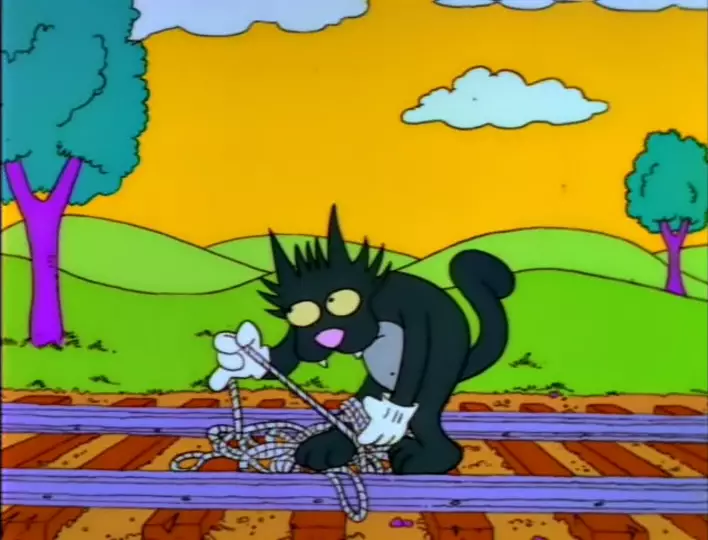
21:57. “Itchy’s a jerk.” I like this ending, as it wraps up the emotional stakes of the episode, but I really wish both the path there were better organised and that they’d kept it up. As the show degraded, the future episodes became the best ones there was actual new material to cover. Having the series establish a future that each moment in the show is supposed to be building to, or having that build not come to fruition, would make for a novel narrative approach I’d like to see someone try.
The First Annual Gabriel Morton Awards for Outstanding Achievements in the Field of Simpsonness.
BEST LINE.
The thing about a comedy is you expect to laugh, and you expect things you are shown to be funny. Deliberately showing something that isn’t funny when it should be funny can be funny, but it risks wasting an actual joke space on something the viewer may simply interpret as a failure. While going hard on an anti-joke can be worthwhile, the safe bet is the first runner up, Lisa shouting, “WE GOT BEETS”.
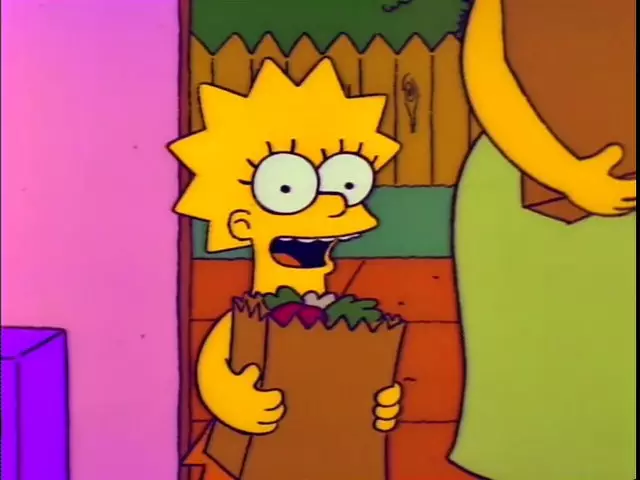
The moment has visual and audible focus, but very little. The line is kind of silly—who would be excited to have beets? —but not enough to be described as comedy and particularly not when Lisa is probably nerdy enough to just really enjoy beets. It’s a mess of possibilities that don’t reach a satisfying conclusion, blended with the sense that you’re probably reading far too much into it, but it’s there and it’s focal, so it has to be something. The result is funny the same way a still image of a vast underwater wreck is scary, suggestion that disrupts the mind at a level we’re not really conscious of.
The next runner up is in the same category of brain-wrinkle shaped mysteries, but with even less to grasp on to. If Lisa’s line is a deliberate, if baffling, communication, then Willie’s grunt as Homer and Marge walk into Springfield Elementary verges on Solaris.
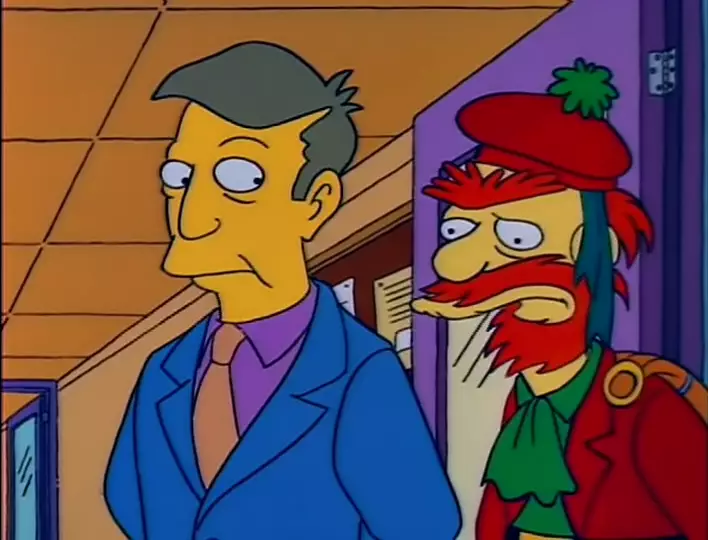
Japan takes the unspoken rules of society, makes them spoken, and then adds extra layers of unspoken rules on top of that. The result is a society and comedy style with incredibly visible structure which has driven a refinement of the eventual absurdities into fundamental comic elements. This kind of thing will happen with in-jokes in friend groups, where, over time, a single abstract utterance can become a stand-in for a funny story and eventually funny by itself.
Willie’s grunt feels like this, which is as close to a meaningful interpretation one can get. Why does he do this? Is he disgusted by Homer? Disappointed there aren’t any attractive parents in tonight? Does this have any connection to his formalwear or is that just a joke at the idea of treating a parent/teacher meeting formally? Skinner looks at him but says nothing. There’s no shot of Homer and Marge to add any more context. There’s no other speech, just the lonely sound of footsteps on concrete and Willie’s disappointed grunt. It’s a form of comic pareidolia. A deliberately constructed scene that swears it’s an accident, and it will be with me to my grave.
The next runners up thrive on delivery, with “switching my birth control pills with tic-tacs” coming up first. Bart’s misbehaviour is always categorized as “youthful mischief”, and most of what we actually see him do, though sometimes exaggerated through cartoonish flexibility, fits that definition. Much like Homer’s eloquent marriage proposal to Marge having to find a way to exist without him delivering it, Bart’s “youthful mischief” can be refolded into a denser joke by adding things that definitely don’t fit that category. Fucking with someone’s birth control is absolutely not “youthful mischief”, which makes its inclusion funny, but it’s Marcia Wallace’s venomous delivery of the line that makes it stick. There is hatred here. Not the hatred of a work burden, but an adult’s hate given free reign through just fields.
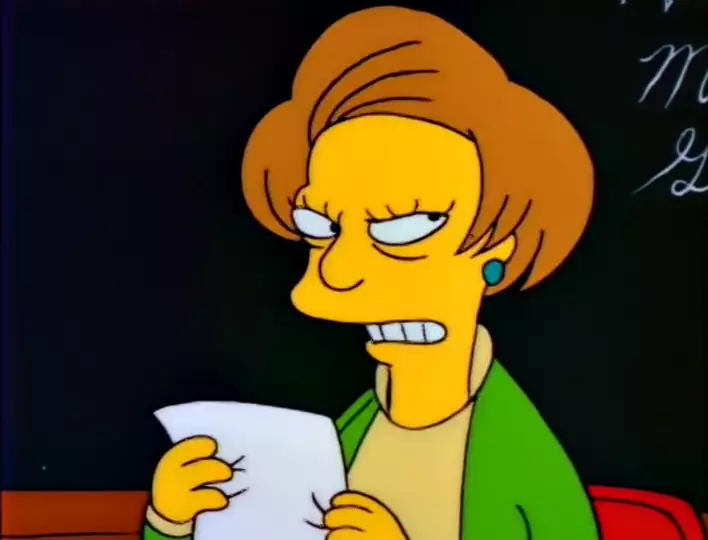
Homer is an idiot, but there are different kinds of idiot that fit different genres and comedic tones. One of the ones that The Simpsons seldom dips into is the genuinely medical, as even though the show deals almost entirely in innateness, a diagnosable disorder would rob him of the agency his foolishness needs to warrant comic punishment. While the reality is sad, dancing close to it only to flit away is funny, which is why his line, “I like stories” is the next runner up.

Homer’s stupidity is like a dark family secret in that it is seldom acknowledged let alone seriously discussed, which is what makes Bart’s lead-in, “Dad, what’s the point of that story?” a unique one. There’s a concern in Bart’s voice, a rare tone he takes with his father, but also trepidation because he already suspects the answer won’t make things better. Homer’s reply isn’t funny on paper, but it works as the perfect comedic crash pad for Bart’s irregularly serious concern because Castellenata’s delivery is deftly void of any hint of self-awareness. It’s a dumb guy joke that should be concerning but rips the possibility of serious regard away from you, creating an inversion layer within itself and spicing up a well-trod concept.
But the winner is…
As mentioned in the article proper, the entire sequence of Bart getting rejected by the cinema cashier is to answer the obvious question the audience will have based on their understanding of Bart and his adherence to rules. Similarly, there is a moment within the Maggie Driving sequence that addresses a question the audience may have based on their understanding of real-world reactions to an infant on a joyride.
Wiggum and the Springfield PD are established as being at about Homer’s level in both intellect and overall competence respectively, so using that to explain some wild happenings in the town is natural to the story world. Internal logic to absurdity helps create a background stability that naturalises the comic happenings, keeping them as funny generated by a setting and not a joke being told at you by a writer.
An easy and common use of the Springfield PD/Wiggum is to show them attempting to do the expected thing but comically failing due to ineptitude. Part of their clever use in this situation is that they don’t do that, and instead opt to demonstrate said ineptitude by not even registering Maggie’s joyride as a problem, which both fits their comic roles and helps neutralise any sense of real threat that may corrupt the joke. Wiggum’s line, “Aww, isn’t that cute? A baby driving a car” is great because it serves both these purposes well, but because it works by warping a normal reaction to precocious infant behaviour, it creates a recursive multiplier by being a joke about a slightly incorrect social reaction while being a massively incorrect social reaction.
Then there’s his next line.
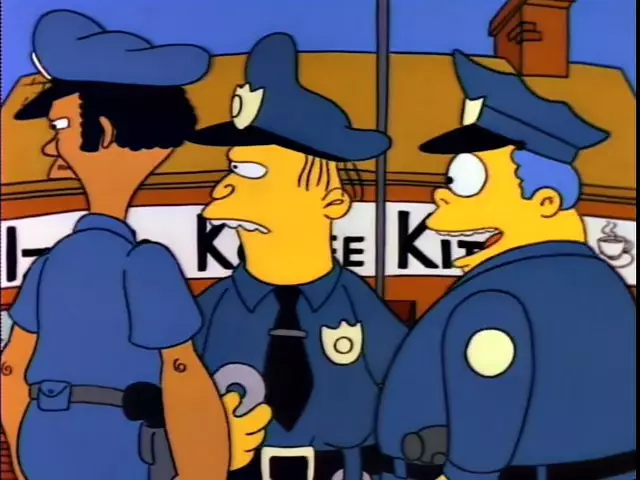
The winner, “And look, there’s a dog driving a bus” is the kind of joke that defines the show. There is a lot to his first line, and many shows would stop there, but the shot lingers on Wiggum, Carl, and Lou for two whole seconds before adding another twist. The structural similarity of the joke, incorrect reaction to something driving that shouldn’t be, is doubled by being about an even more dangerous and improbable situation then further enhanced by inverting the first absurd joke into a relatively sensible setup for the second. This is the kind of beautiful internal complexity that generates a whole more than the sum of the parts.
BEST SIGHT GAG.
The first runner-up is Grampa leaning in to break Bart’s teeth. The joke of the scene is Homer being so incompetent at disciplining his son that even his sincerest attempts to mimic the basic idea while still being batshit. Grampa’s enthusiasm for it is a great choice as it demonstrates a familial transmission of the problem across generations, but it’s also deeply sinister in its sincerity, fuelling a great reaction from Bart. The shot is static, which adds to Grampa’s lean-in, but a lot of the joke is still in Grampa’s dialogue which hurts it as a pure sight gag.
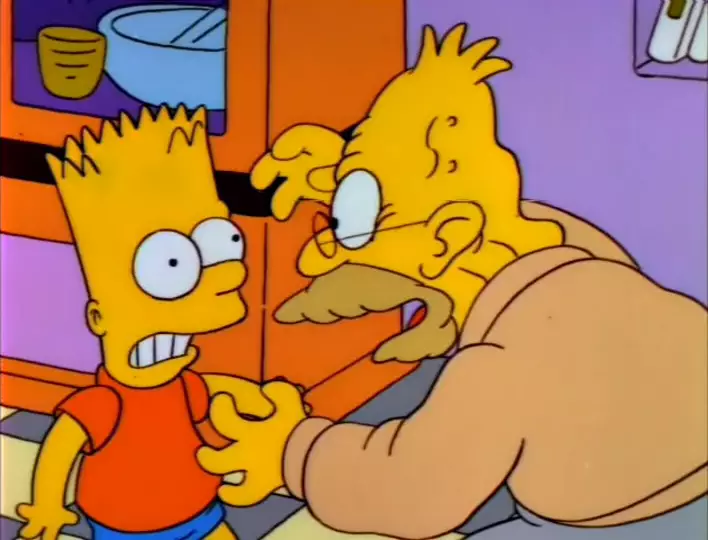
The juxtaposition between the very cute and the very violent is far more common these days, but Itchy and Scratchy’s specifically PG blend makes for some fun balances freer media has no reason to do. The second runner up of Itchy leaping into Scratchy’s head and playing with his brains is incredibly violent, but there’s no blood, just scraps of ticker-tape brain matter floating to the ground. Any other show would have the corresponding blood level, but the lack of it here emphasises the commentary I&S is making on the nature of sanitised violence.
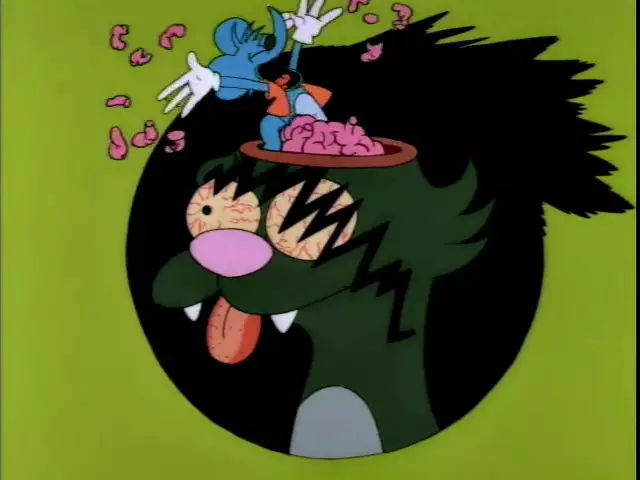
There’ll be a modern analogue for our next runner up, perhaps some kind of TikTok trend or something, but the sight of Al Capone dancing The Charleston on top of a flagpole is such a specific joke about a specific thing that I don’t think the details of it will translate to modern viewers. The Eye on Springfield bits are perfect encapsulations of 90s magazine programs that weren’t educational enough or interesting enough to warrant even the derogatory title of infotainment. The target audience of these things were people in holding cells, Grandmas startled by sliced bread, and coma patients, so they mastered a form of compressing complex concepts, entire cultures, and whole historical epochs into a dense stereotype paste downloadable by their low-bandwidth viewers. This is a joke on these mish-mash collages, but lasts because sometimes Rowan Atkinson in a cupboard, acting like a dog, and eating tiny bananas is three times funnier. That he falls is a really good choice as it adds a kind of spurious rigour to something that would never even need it, creating a layered depth to something that would otherwise be a Late Night with Conan O’Brien reject.
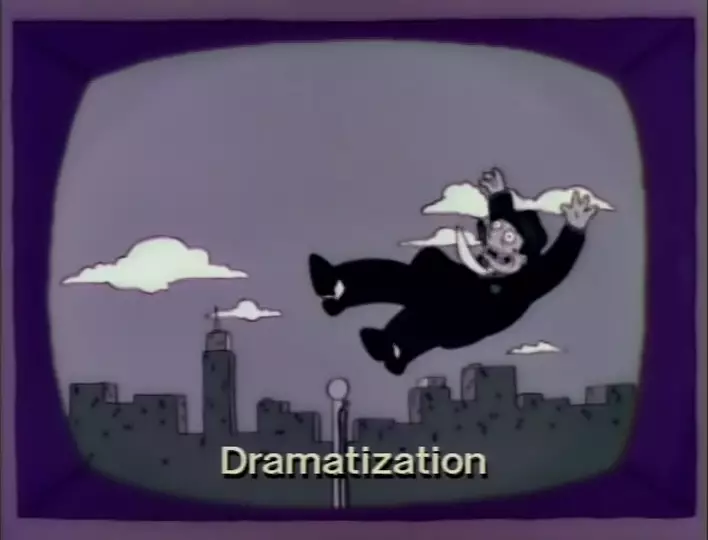
BUT THE WINNER IS…
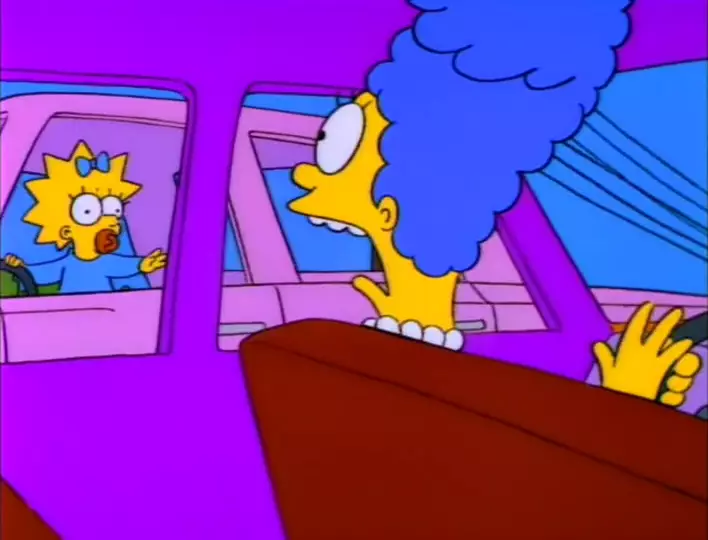
This episode is a little bit of a mixed bag in terms of sight gags, with a few being so broad and focal as to wind up overdone. The I&S billboard is a good example of one with too many edits and effort for what is a fairly dull gag, but then there’s this one. The sequence of Maggie driving the car is already very joke dense, but this is an example of what you can do when you refine the edge of one joke so much you get something categorically new. Like the difference between a kitchen knife and a scalpel.
We know Maggie isn’t going to tragically die, so that and the delightfully adventurous music sets an upbeat tone which shifts Marge finding out into joke territory. Unlike other cartoon babies, Maggie is a baby, so there’s very little of her perspective in the show. The driving sequence never shows her view or a shot from within the car (also to avoid questions of mechanics), instead it shows the chaos it wreaks on the people around her from the perspective of other characters and the show’s standard omniscience. It has been established that Marge isn’t home (that was why Bart was watching her in the first place), so having her perspective, seeing her infant daughter drive down the road opposite her, is both a hilarious reveal and well established within the narrative and shot sequence.
Amidst this chaos, in the perspective of a mother seeing something as shocking and frightening as all this, her baby just sees her and happily waves as if all of this were perfectly natural. Comedic juxtaposition tends to be the insertion of an absurdity because it’s what our lives are lacking. Sloppier works will pile the ridiculous on top of the ridiculous, creating a giant burger that’s novel to look at but impossible to actually eat. Turning the plain into the absurd like this demonstrates keen comic talent, is a great joke itself, and a reflexive meta-joke in one single second.
Best Overall Joke
The first runner up demonstrates the sophisticated artistry at the heart of good comic stupidity, it’s Homer missing the moon landing. Homer is a comic oaf, the kind of idiot character who does a lot of physical comedy, and this lends him to similarly broad approaches to making him look stupid. There’s nothing inherently wrong with this approach or right about doing the opposite. The artistry shines in recognising that the broad oaf stupidity can be harnessed as a setup for the occasional subtle form. He has headphones on because he’s listening to “Yummy Yummy Yummy”, a piece of bubblegum pop whose band was entirely session musicians doing a job. His eyes are closed because he’s enjoying his trivial piece of distraction. He is one metre from the TV. Every choice here is a brilliant one because each is completely avoidable, making the fact that he missed it so perfectly frustrating to anyone else.
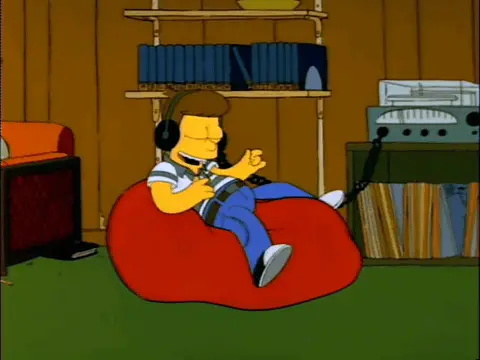
The thing about the juxtaposition of cute and violent that something like Happy Tree Friends used was that the violence was extremely graphic, but still in a cartoon way. Things like it, Mortal Kombat, and Evil Dead can be extremely gory but the exaggeration of it makes it as unreal as everything else. What makes the second runner up, Scratchy groaning as he crawls on his shot-out kneecaps, really funny is the fact that the violence is kind of serious. The hyper-cartoony nature of the violence in other Itchy and Scratchy examples and Happy Tree Friends creates a light-hearted tone that works to make laughing at the violence okay, even as it’s depicted with plenty of red. The Steamboat Willie aesthetic is even sillier than the standard I&S, so the enhanced seriousness of Scratchy’s groans and realistic pain works to both reorient the comic juxtaposition and to exist as a piece of absurd seriousness amidst what is still a comedy. It’s incredibly funny, but usually gets cut from reruns.
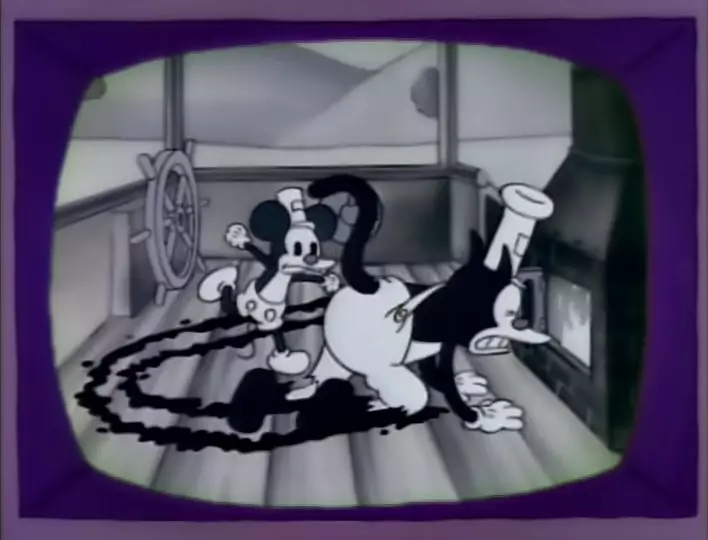
Milhouse is the perfect psychic toilet, Martin is fun to kick around, and Nelson is enough of a jerk that being cruel to him counts as karmic balance, so the final runner up, Arthur, is a curiosity. For the purposes of the moment, Milhouse would have fit perfectly well. Bart’s Friend falls in Love showed us that he’s just a victim Bart labels a friend, and the idea of Bart jamming fireworks up ol’ Millie’s anus isn’t remotely out of the question. And it was the anus, or the urethra, nobody brings a doll in if someone stuck something up your nose, also nobody looks like Arthur looks if someone stuck something up anywhere above the waistline. The comparatively simple emotional palette of children struggles with certain forms of the grotesque, and the resulting blend of shame, disgust, and confusion is remarkably similar across children dealing with confusing butt stuff. Milhouse would have worked here, but he would have worked here because Milhouse is a joke. Arthur is serious, which is what makes the image of him standing in front of a doll that is clearly modelled after him (in what I’m hoping is an animator not thinking about the underlying logic of that) even funnier. We laugh at Milhouse like pigs in a trough of the vilest human joys, that we can’t with Arthur really elevates the structure of a fairly common bit of black humour.
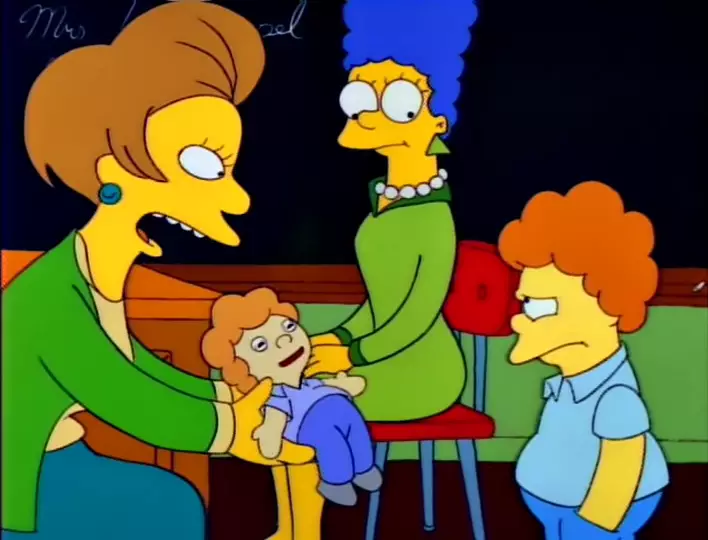
But the winner is
Surprisingly little has changed about childhood destructiveness. Bart’s sitting in the sitting room, smashing mustard packets with a hammer, all while singing “Jingle Bells”. I cracked my own skull open with a hammer doing something similar, just replace “mustard packets” with “bits of concrete” and “loungeroom” with “backyard”. The motivations were functionally the same: just make something happen. The concrete bits exploded in a satisfyingly mustard-packety way, and all because of me. Children of my generation had to make things happen because there wasn’t an internet full of happenings around, but things like this still occur. Smashing mustard packets with a hammer in a loungeroom while singing “Jingle Bells” sounds exactly like a TikTok. All that’s changed are the motivations.
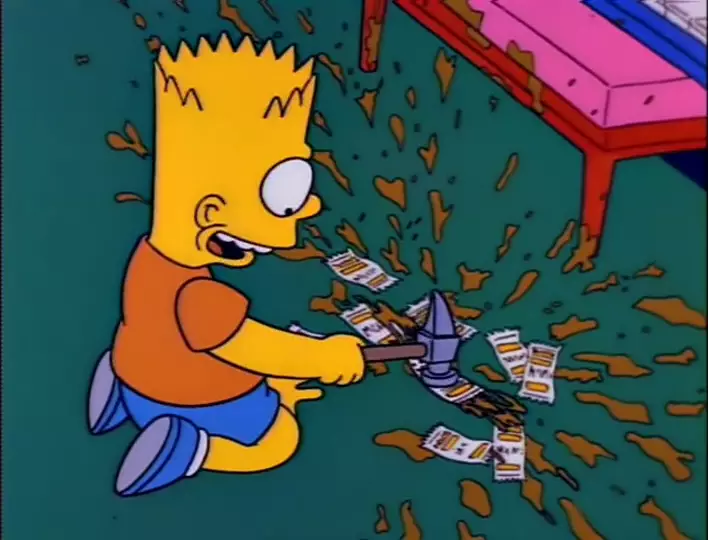
A post-internet child would be doing something like this on TikTok for a different reason to Bart but for the exact same reason the writers made him do it: it’s very funny to an audience. Starting on the mustard packet is a great choice as the juxtaposition between the relevance the shot creates with the irrelevance of a takeaway mustard packet creates a tension. The hammer releases that tension, but in a way that only creates another question. The oblique shot of Bart kneeling over mustard chaos in what is obviously the sitting room answers a question, but in a manner that isn’t helpful. The Jingle Bells, like everything else in this moment, is too specific to be an accident but so disconnected that the very thing that should be holding this altogether is only making things worse. Homer’s furious reactions to most of Bart’s misbehaviours across the series reflect an underlying understanding of the situation, but here he demands to know why Bart is doing that. There is so little sense in the act that this overrides his rage. Bart doesn’t know. He is not lying.
BEST SHOT
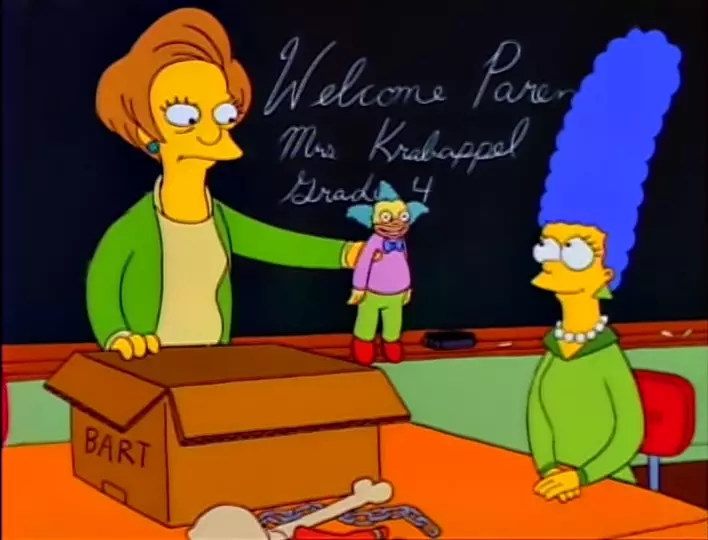
There’s a specific kind of self-aware hope that exists as a life support system for the truly broken. A hope in hope that’s the ouroboros alternative to the noose. Marge isn’t hoping that the doll is a positive, she is hoping to hope because the act alone is one of the only things that gives her relief. Her weak smile can’t get any stronger because that real hope, when dashed, would kill her.
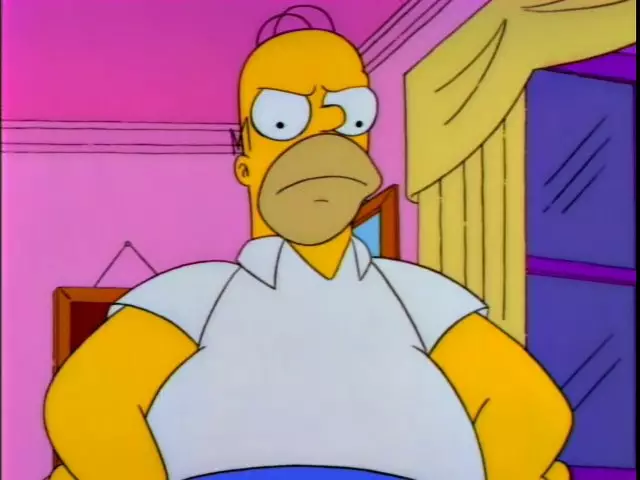
From most angles, Homer’s fat is the perfect comedy ball. It can do all the funny things like squish and bounce, turning an ignorant aggressive oaf into a delightful buffoon. Bart’s perspective gives this an interesting twist as we get to see that, from below him, the cartoon buffoon is an altogether different beast. Homer looms above Bart as a pyramid of authority. His gut is now an immovable base that flows up in a structural counterweight to a frown of the gods. This being how Bart sees him explains most of his behaviour. Homer is an irrational totem to a violent god that Bart doesn’t have faith in. Against an omnipresent icon he can only be an iconoclast and lash out in any way that displeases the god.
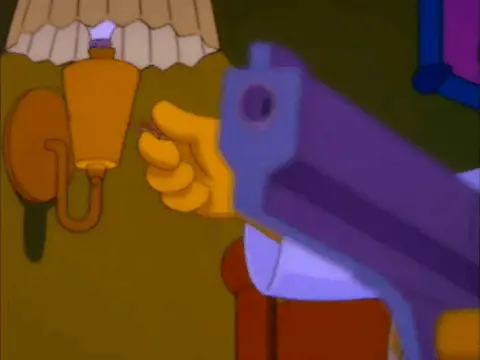
The Gun is the dominant ethnic group in the United States and so controls most of the media. It exists in the minds of the cowed minority citizens with such calm power that it is at once subliminal and explicit, which is highlighted in this shot. A focus pull is an easy technique when you have lenses and objects in a 3D space, the kind of choice one can make on the spur of the moment. Animation cannot, making its existence the result of far more deliberation. The gun does not need focus, its basic shape and sound register in American minds like a mother’s voice, but it wants focus, so it gets it.
But the winner is…
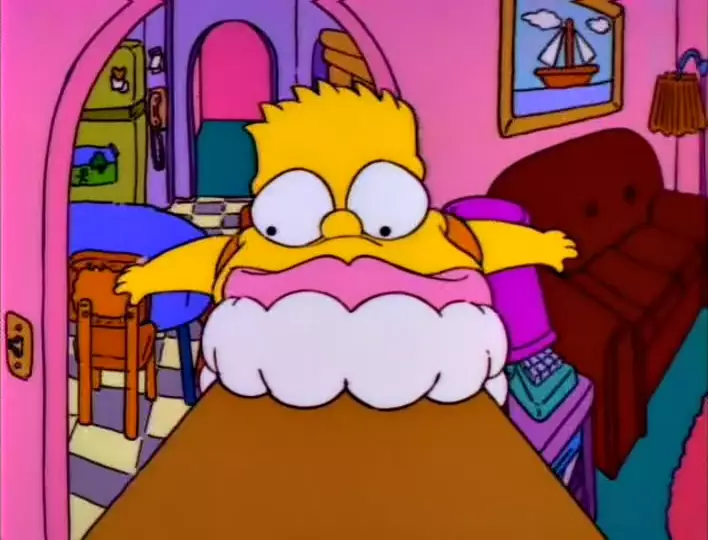
There was this thing Mel Blanc did that elevated him to the top echelon of voice actors which was getting one of his characters to do an impression of another. Doing this when you do both voices without just shifting into the second requires very precise control and there is a similar quality to moments of The Simpsons. When Homer is doing his “magical man from happyland” dance in Flaming Moe’s, he is perfectly animated as a real person acting like a cartoon character. It’s the kind of performance you could see Chris Farley doing, and it makes a good scene a masterpiece.
The first moment we see Bart chomped onto the fan, it’s a cartoon moment that connects with the soundtrack to let us drink in the intended ridiculousness of it. Then we get the shot from the perspective of the fan. One would think that shot choice in animation is easier than in live action—the latter being burdened with various unfair handicaps like physics, while the former simply requires a stable of animators you can emotionally cripple into accepting starvation wages with very little effort—but there are difficulties traditional animation had that led to the use of shortcuts like blur screens and the like. There are none here. Effort was expended to create the illusion of a camera on the fan blade, to make the wildly cartoony seem like it was filmed in front of a live studio audience. Details of other rooms whirl by in the background, Bart’s lips ripple over the dentures, and for a moment such a prank could exist.
Freeze Frame Fun
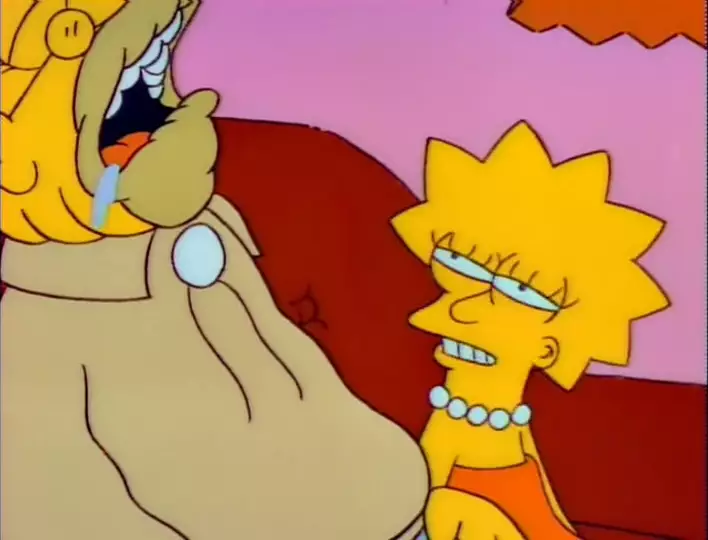
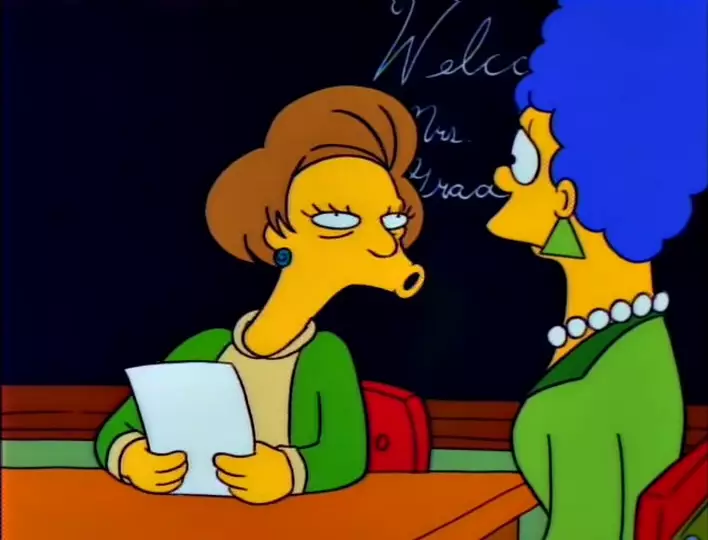
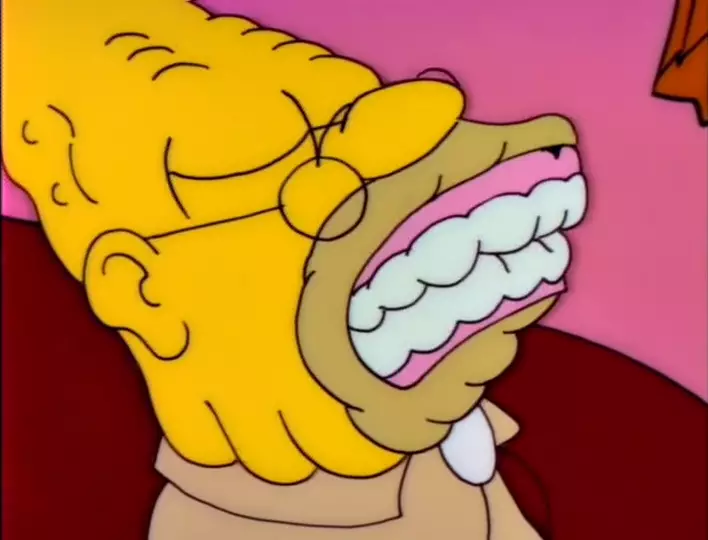
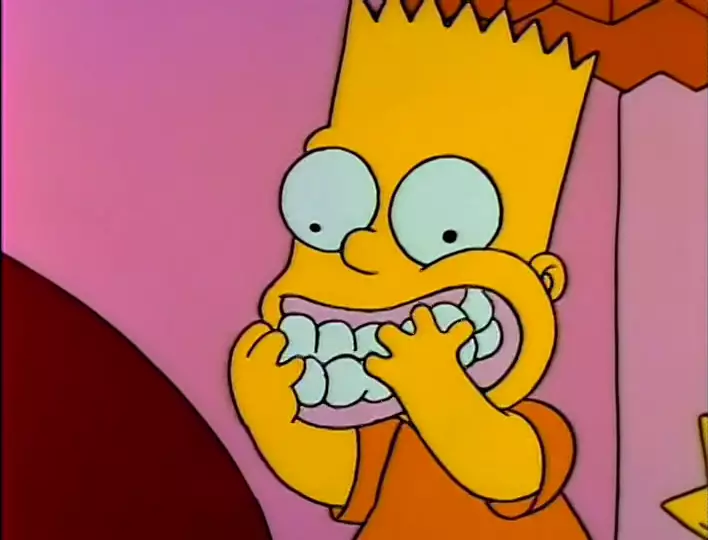
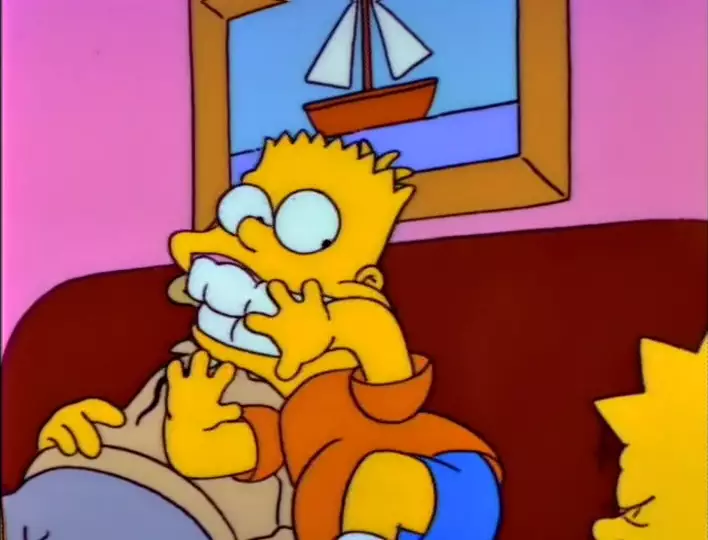
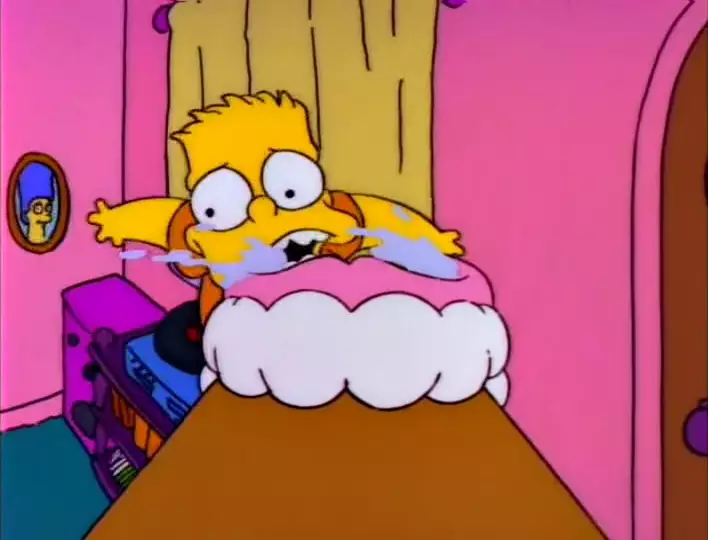
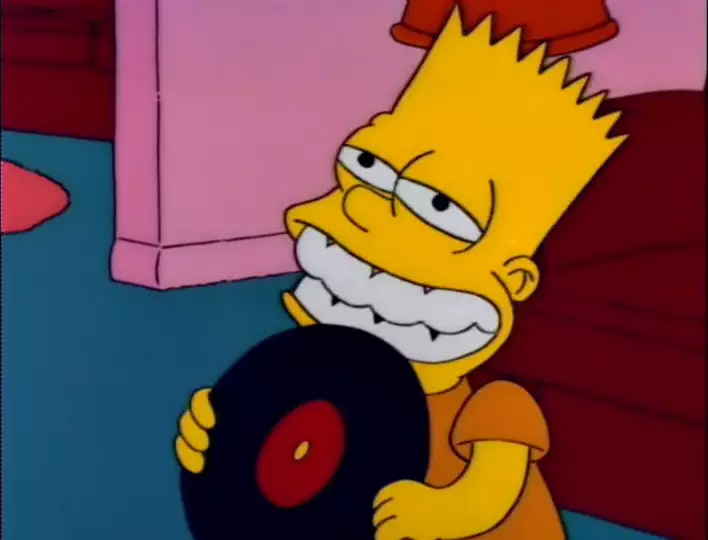
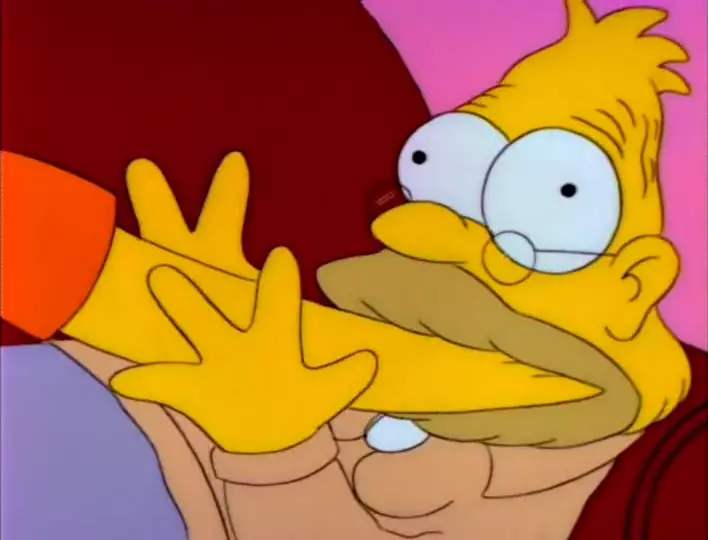


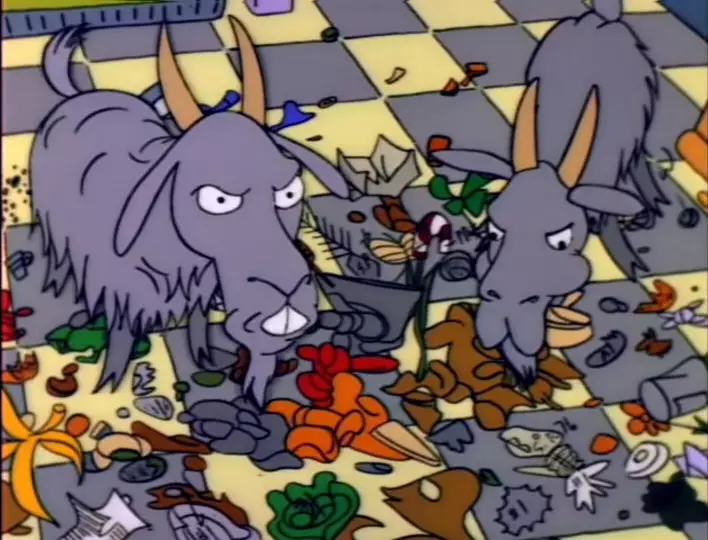
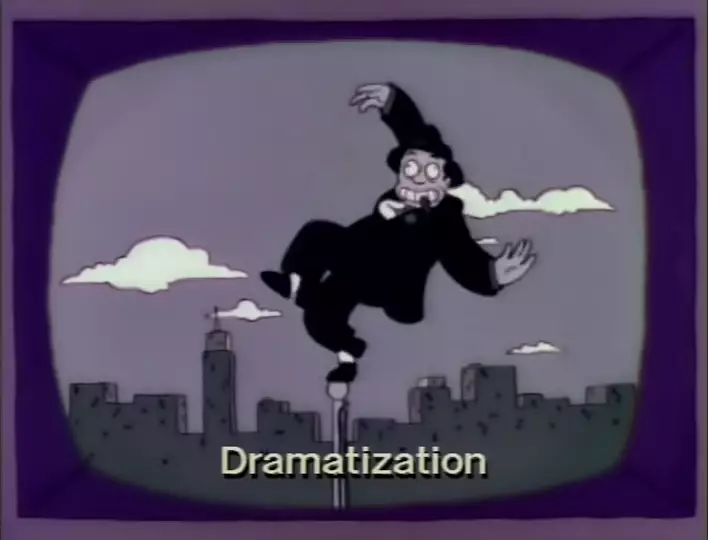
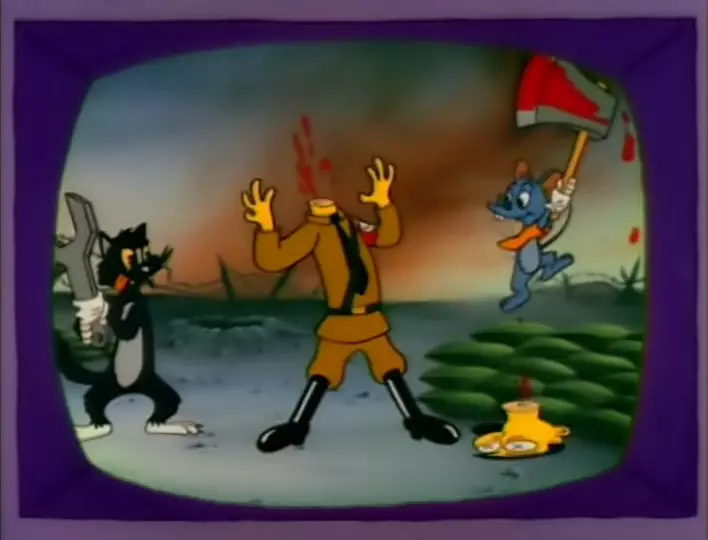
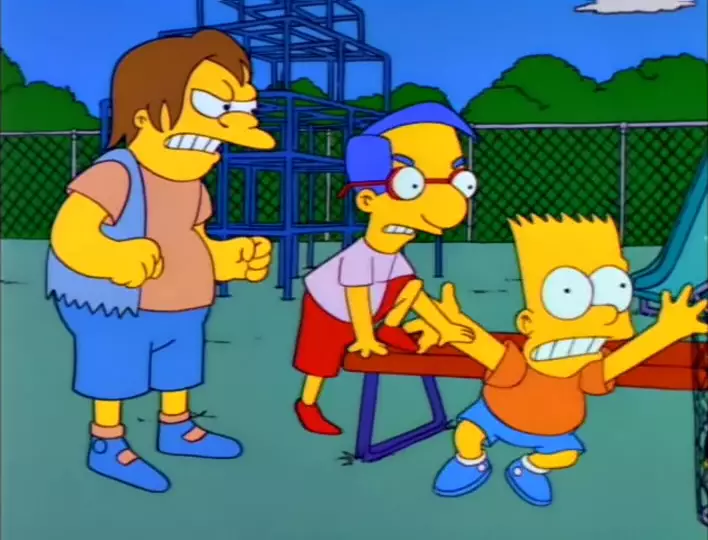
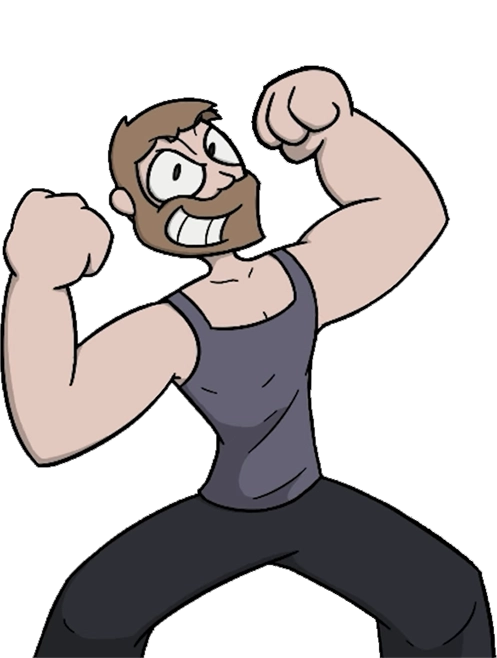
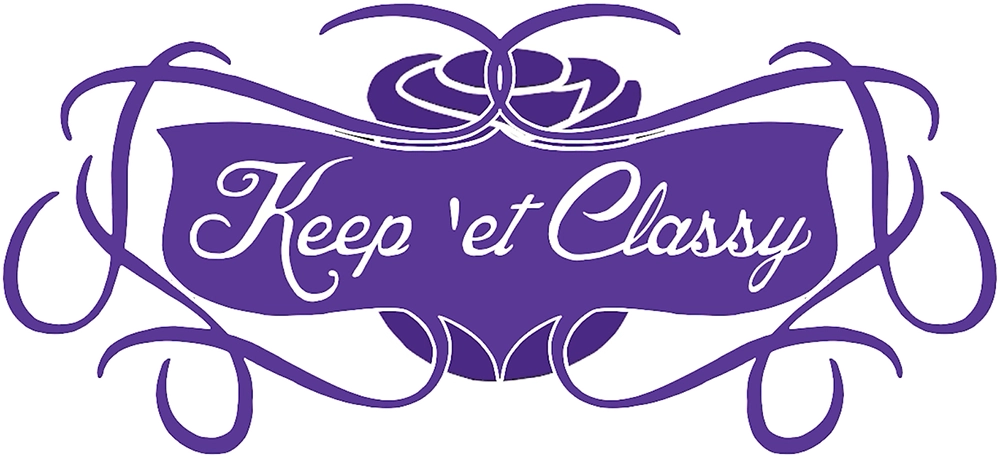
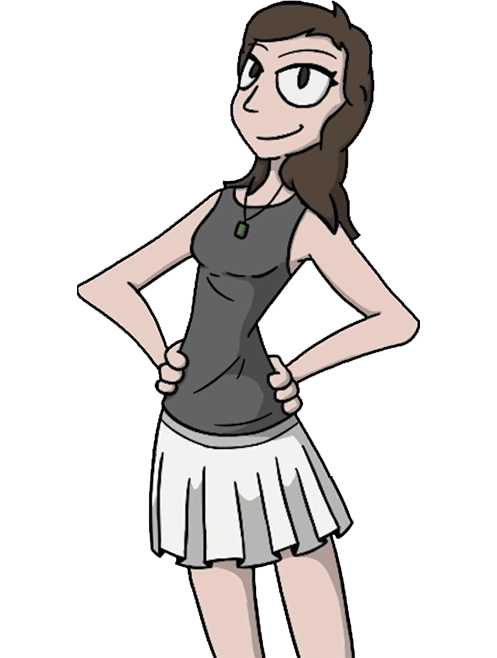
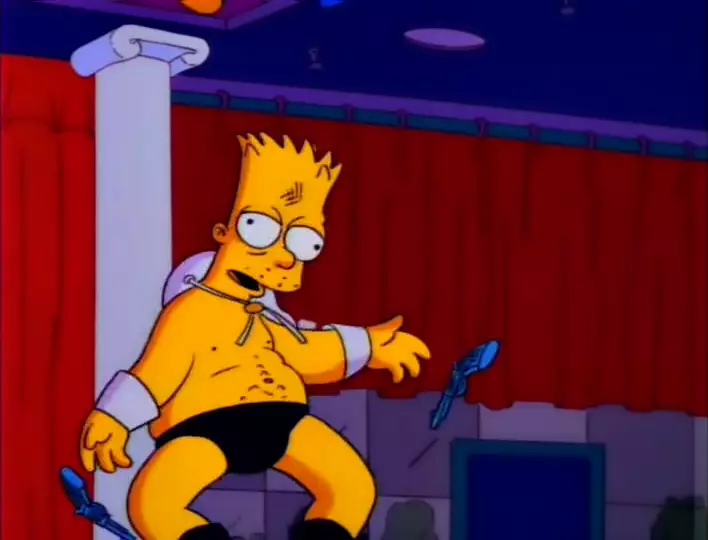

Comment on Itchy and Scratchy: The Movie
To reply, please Log in